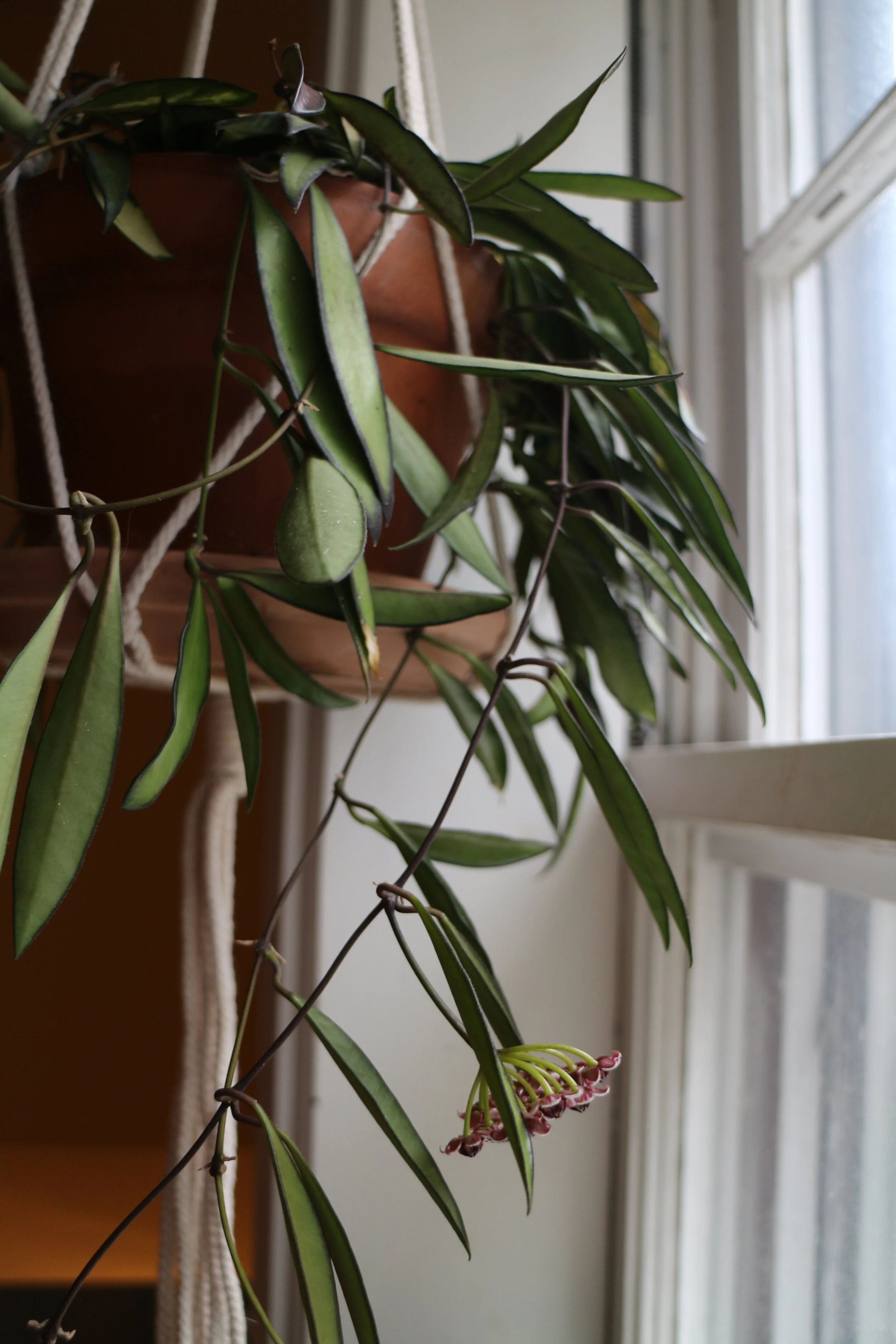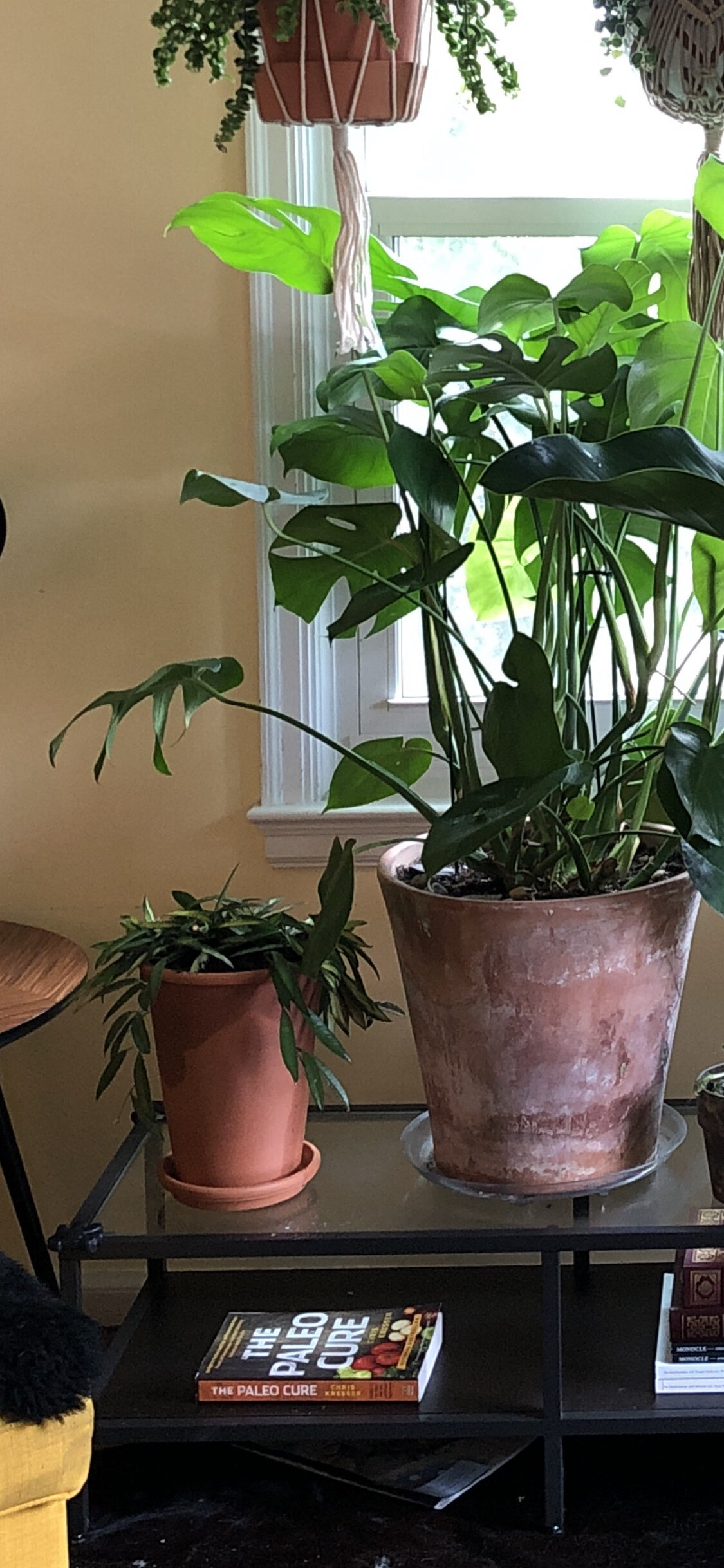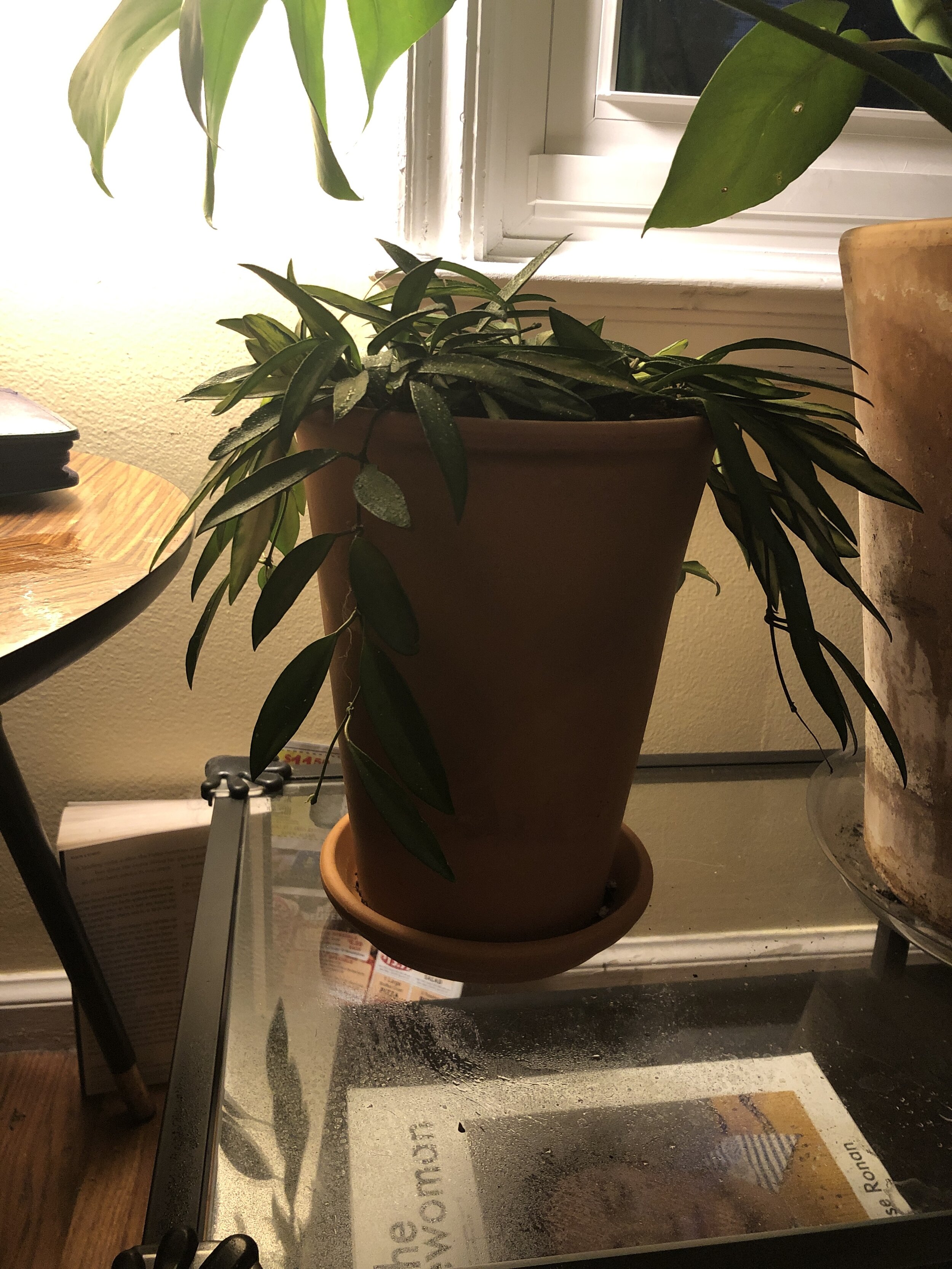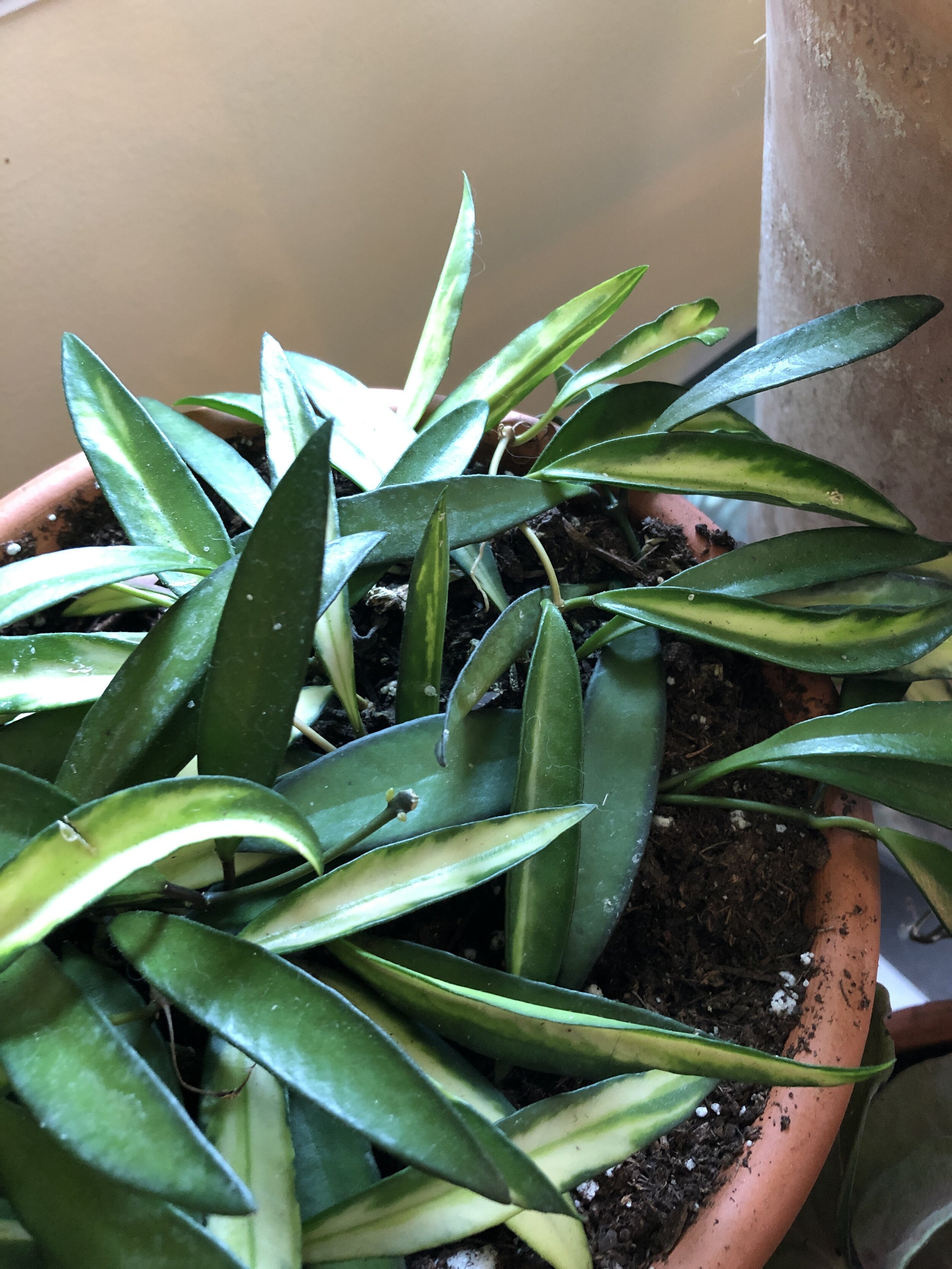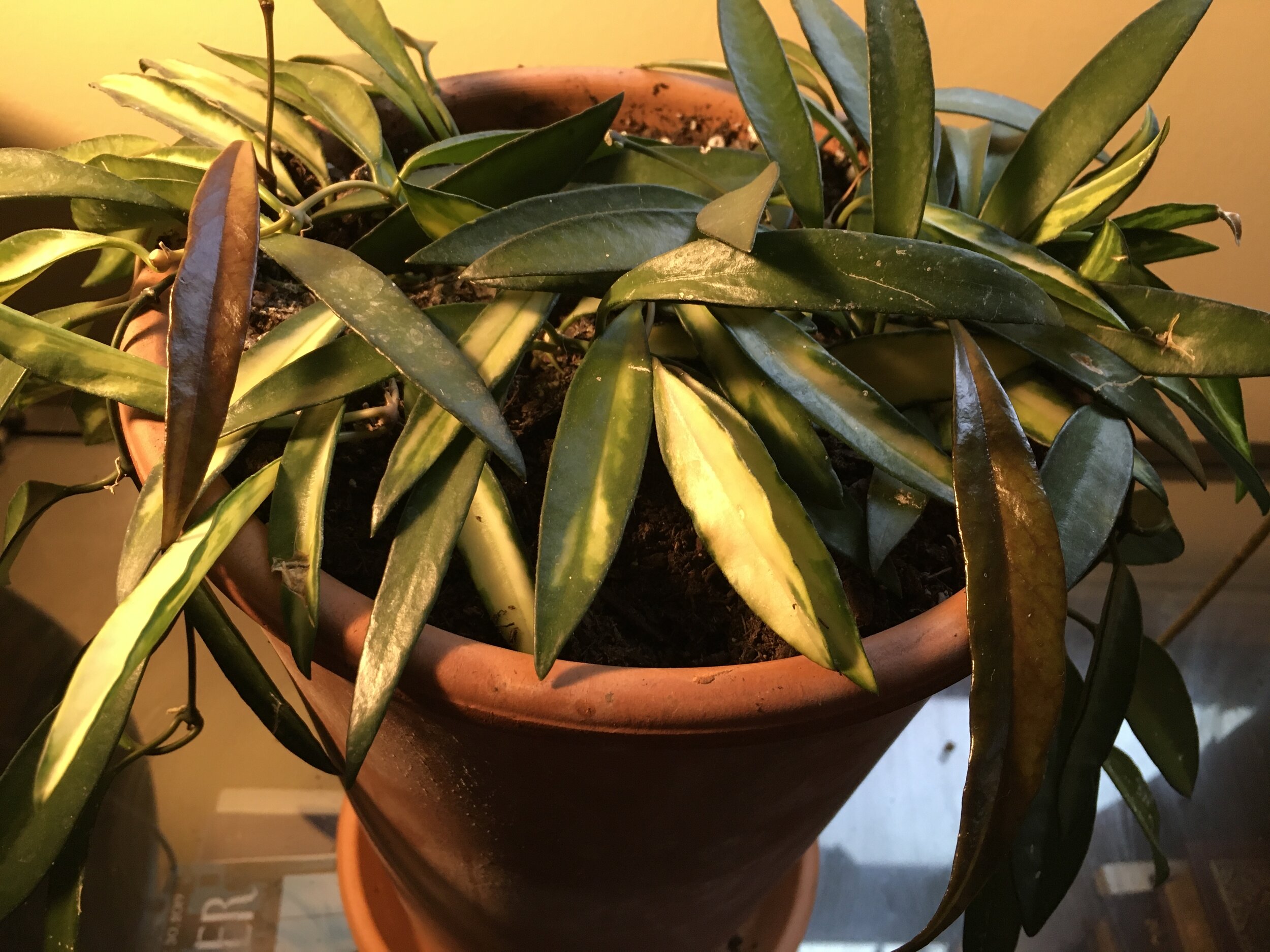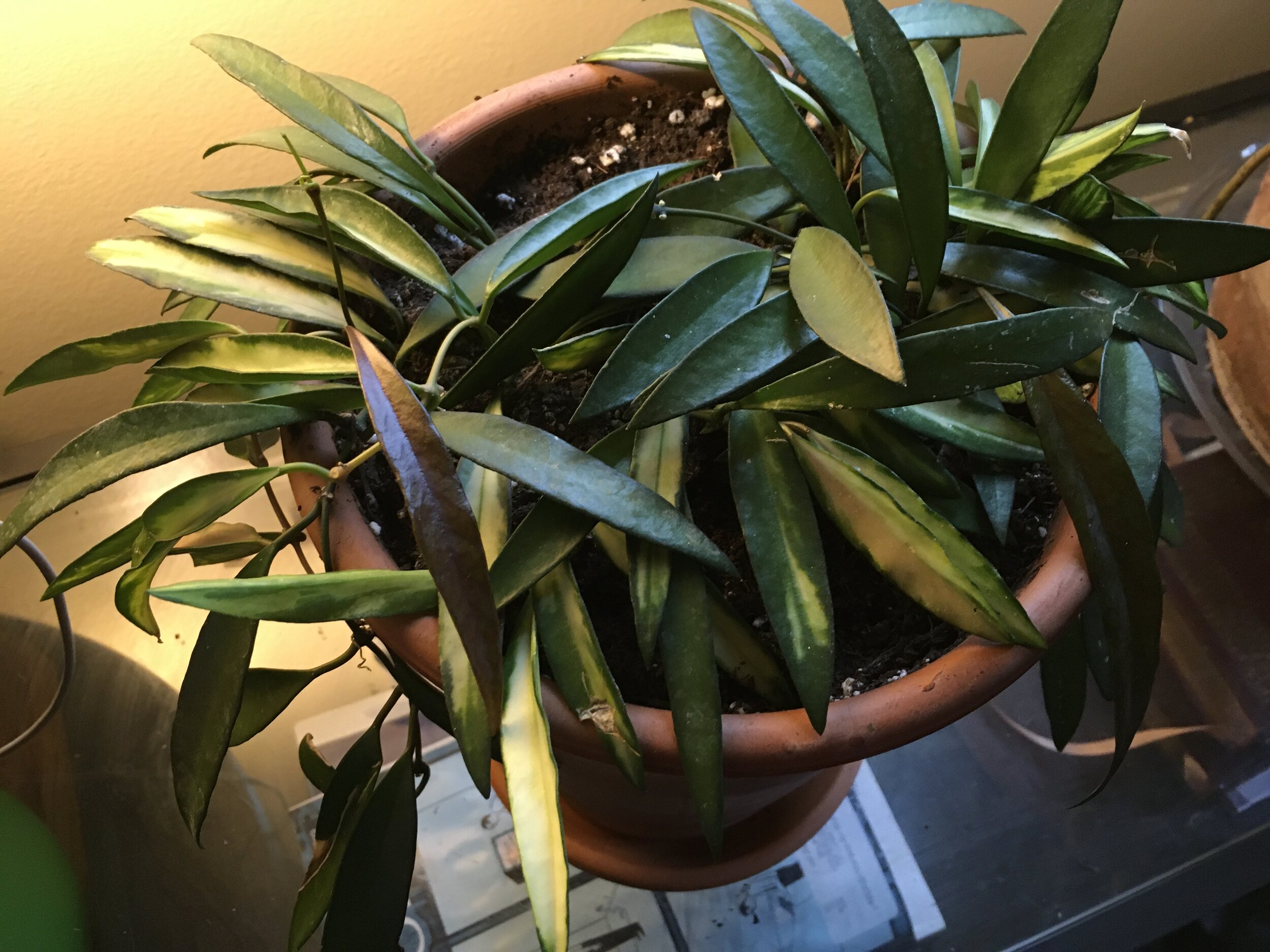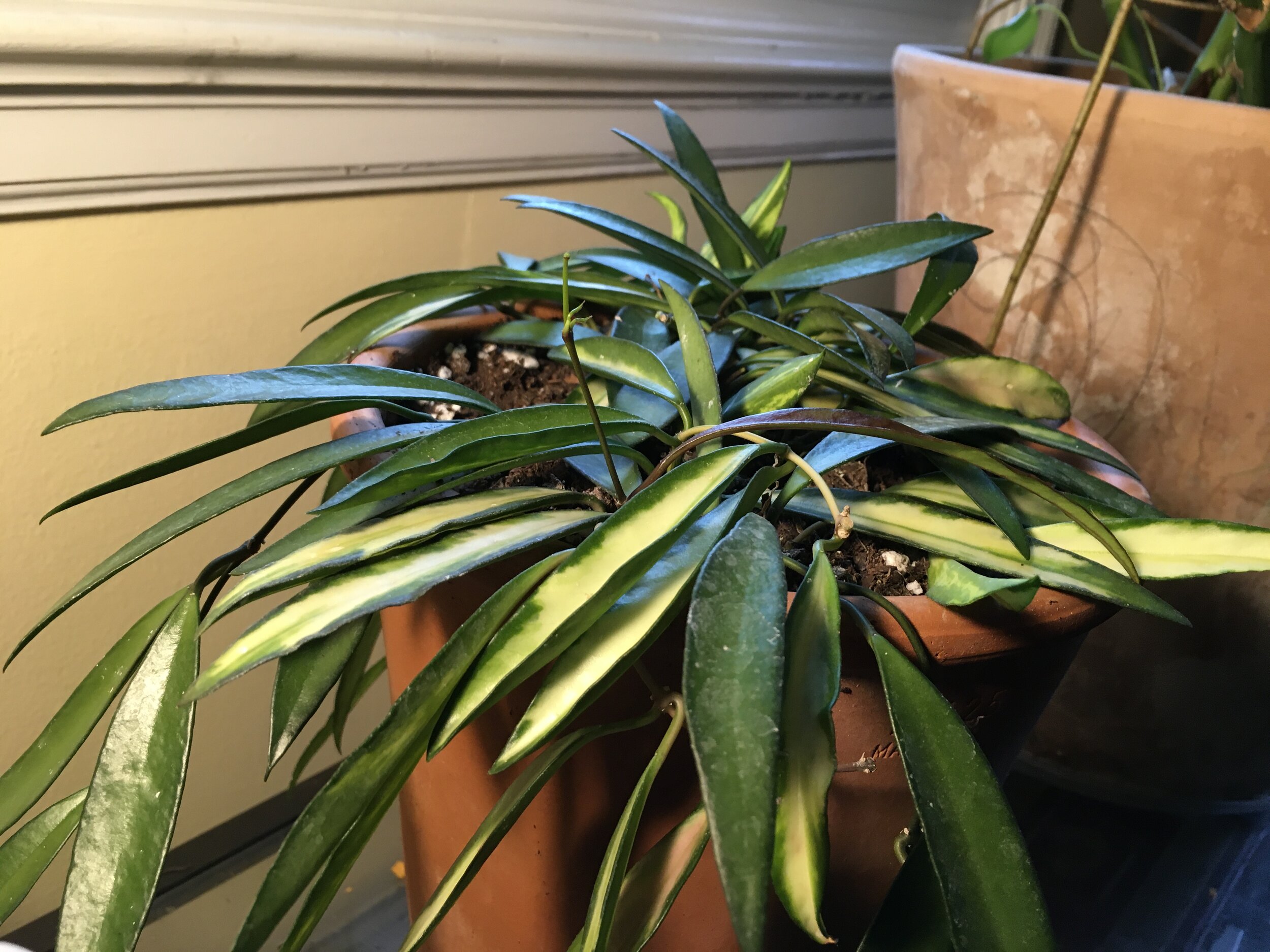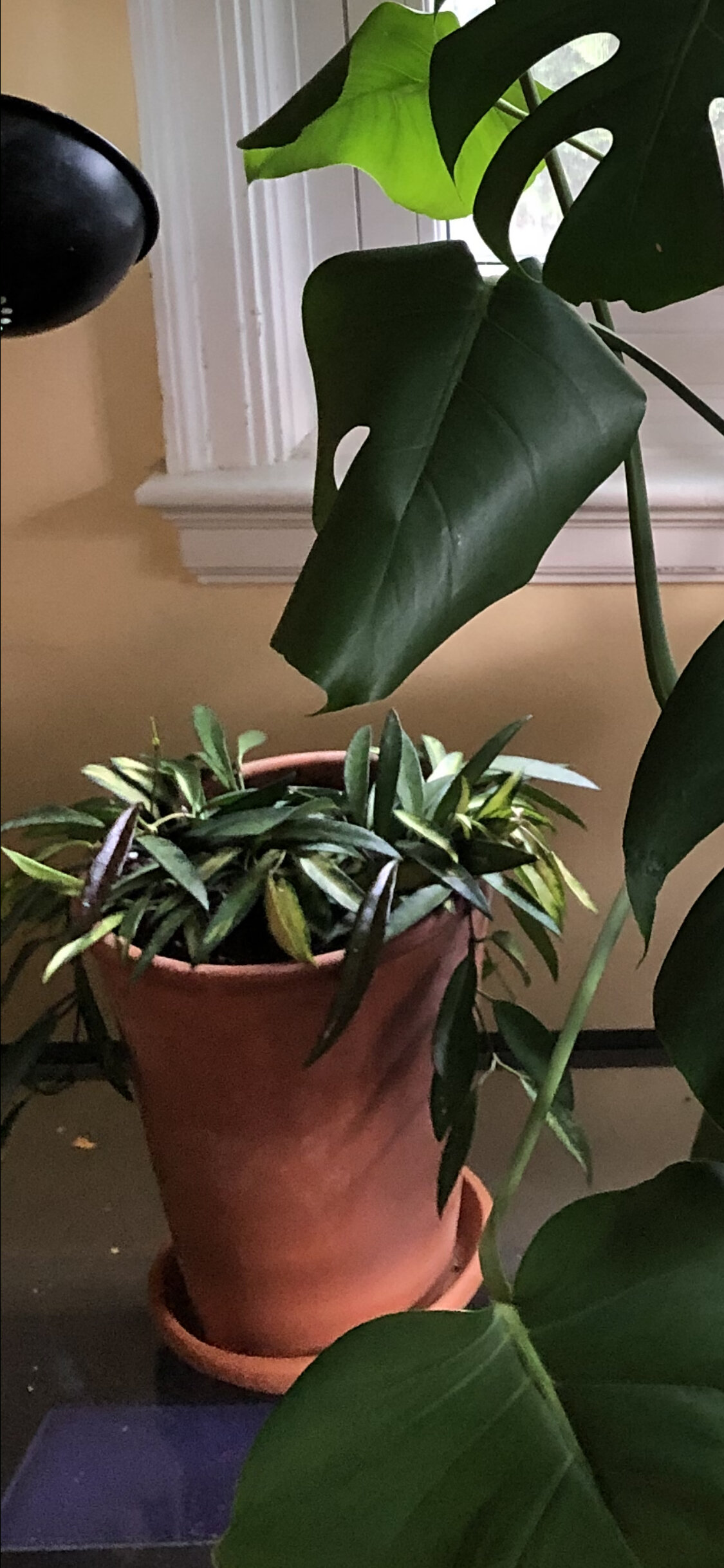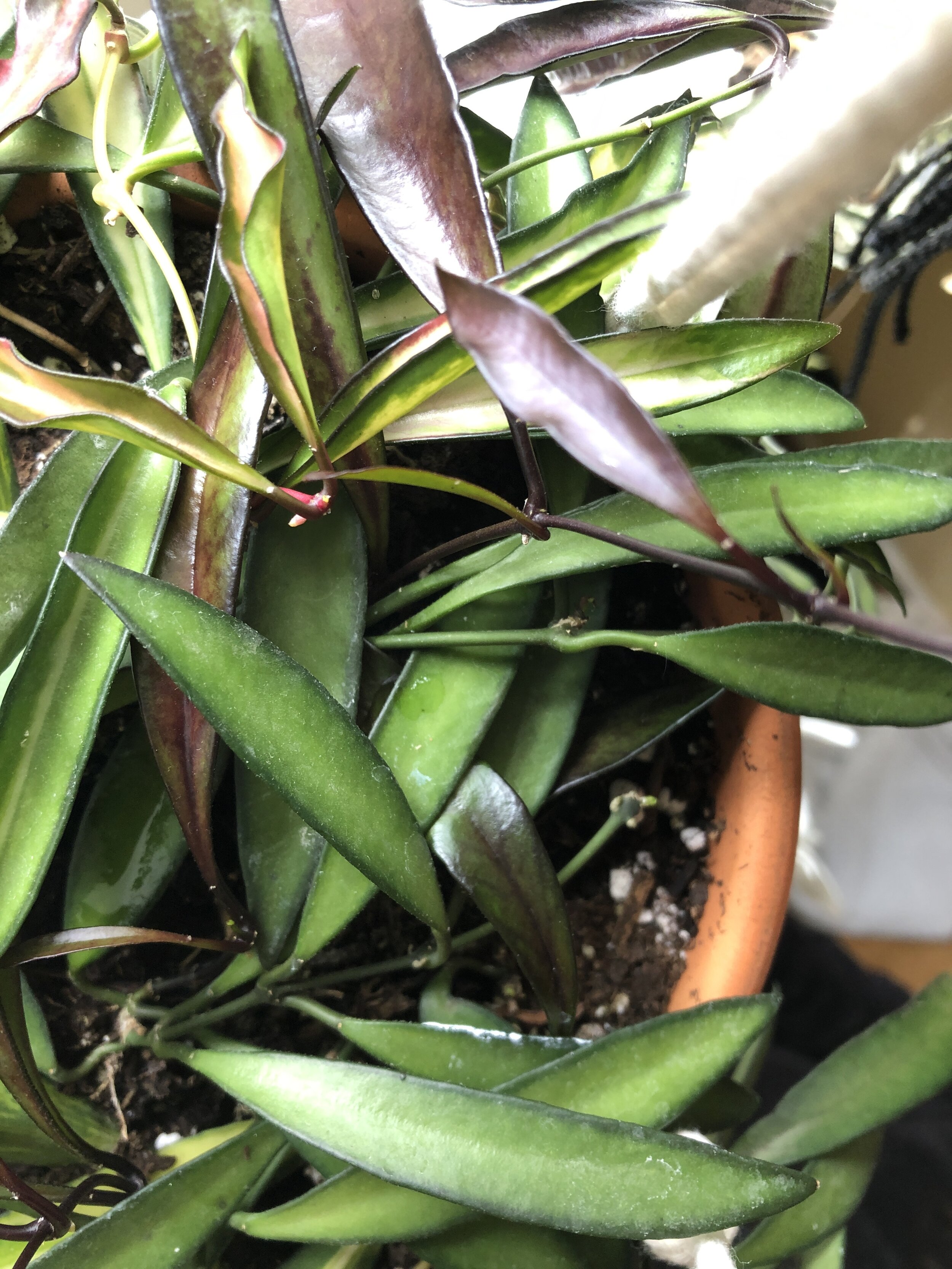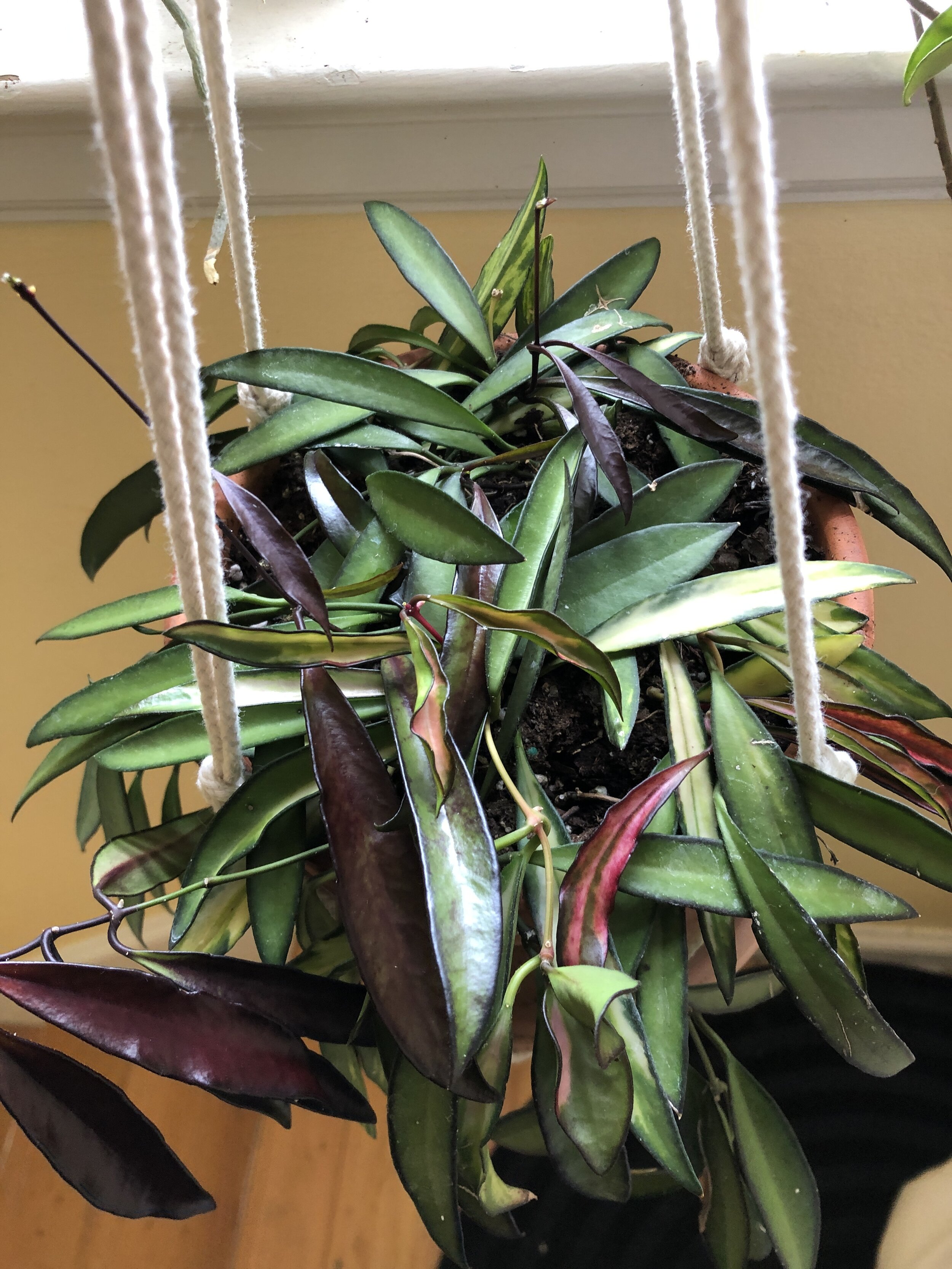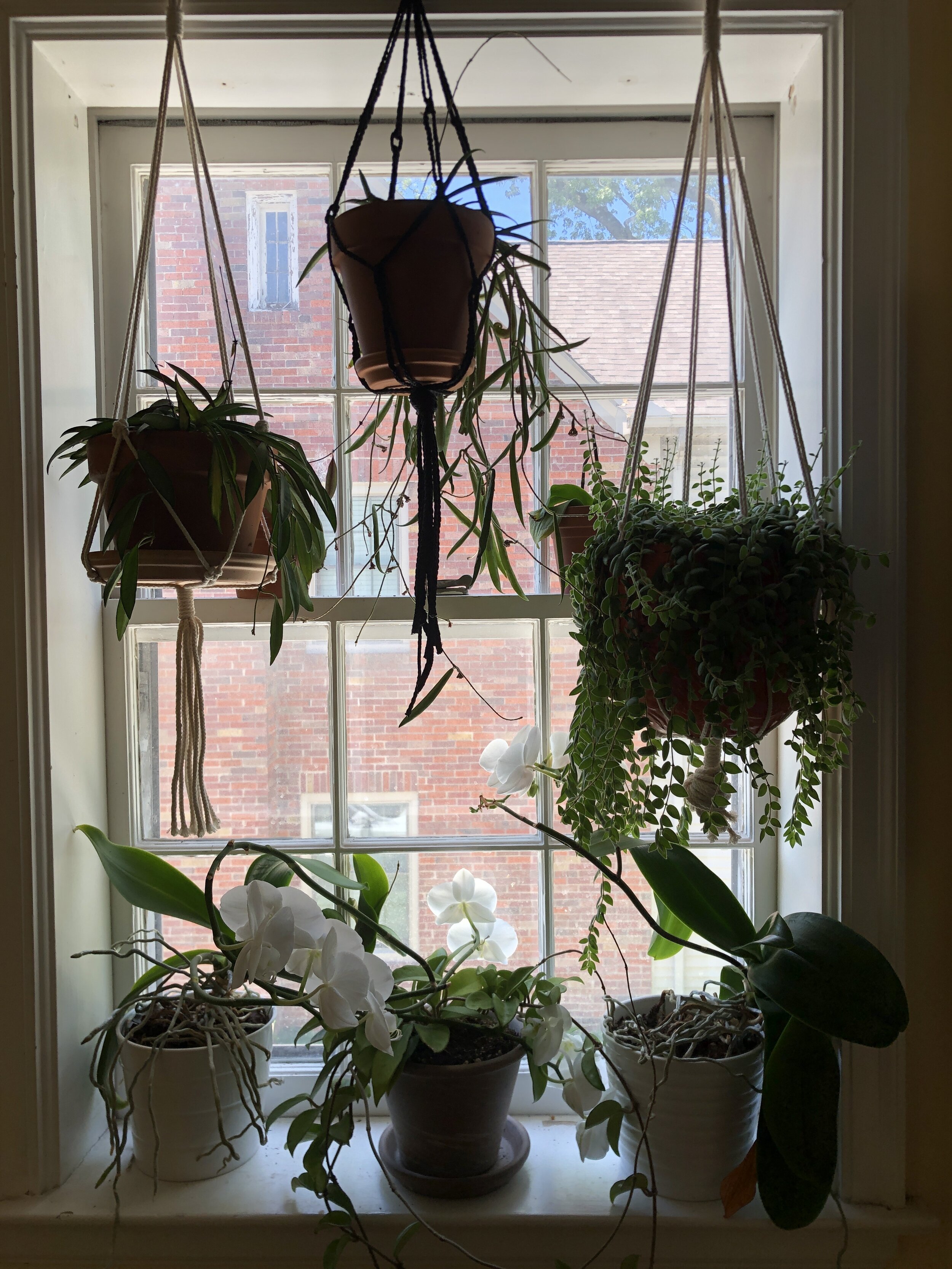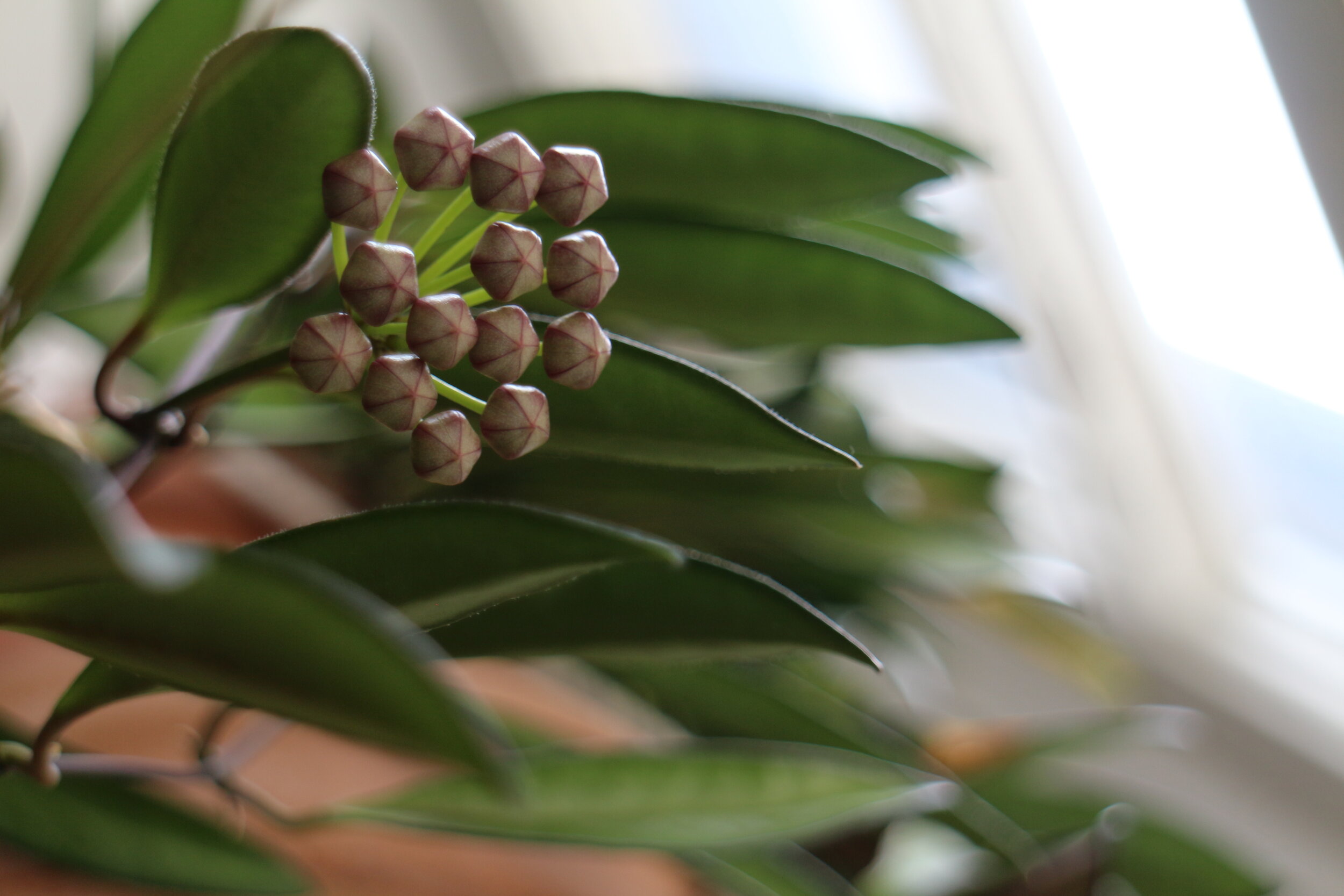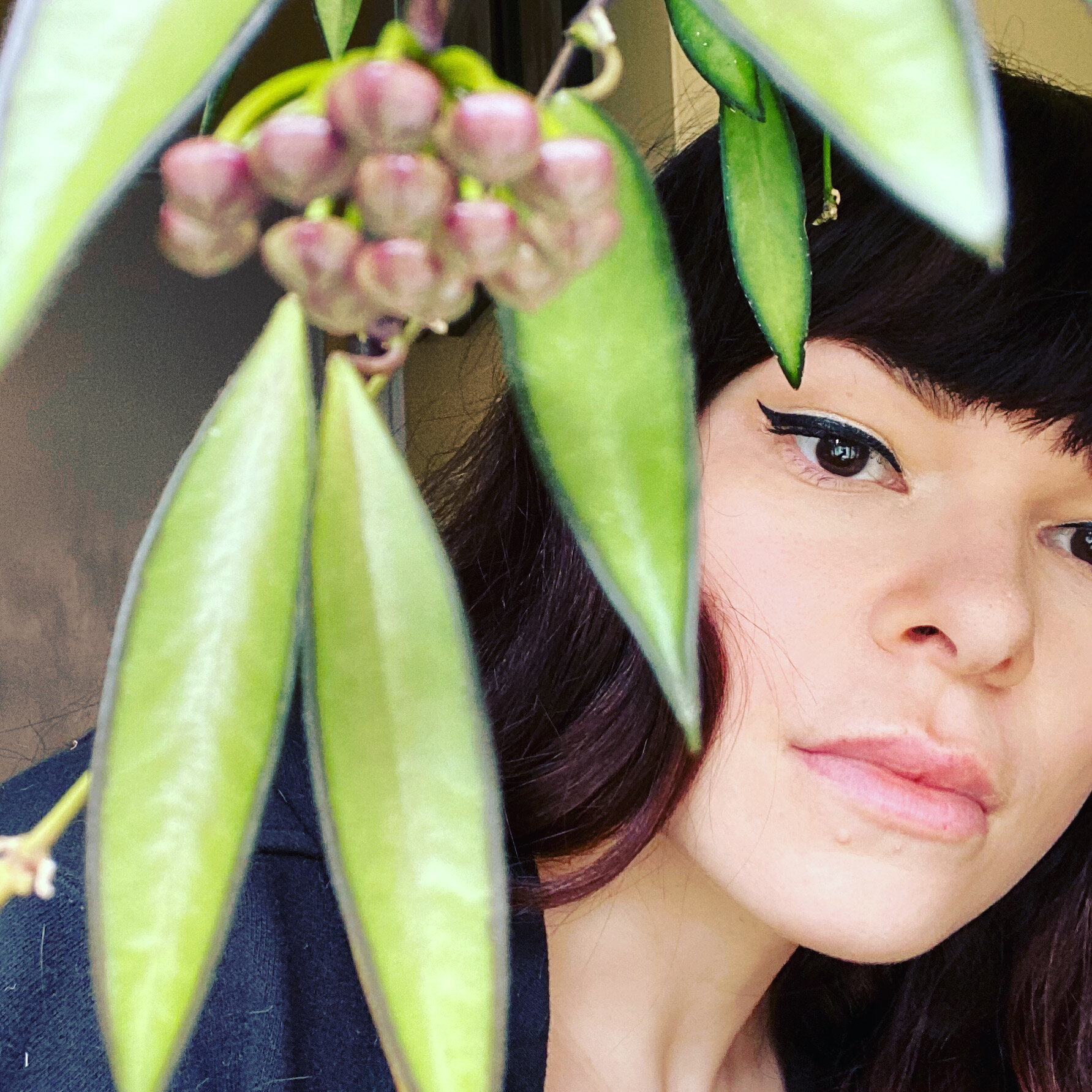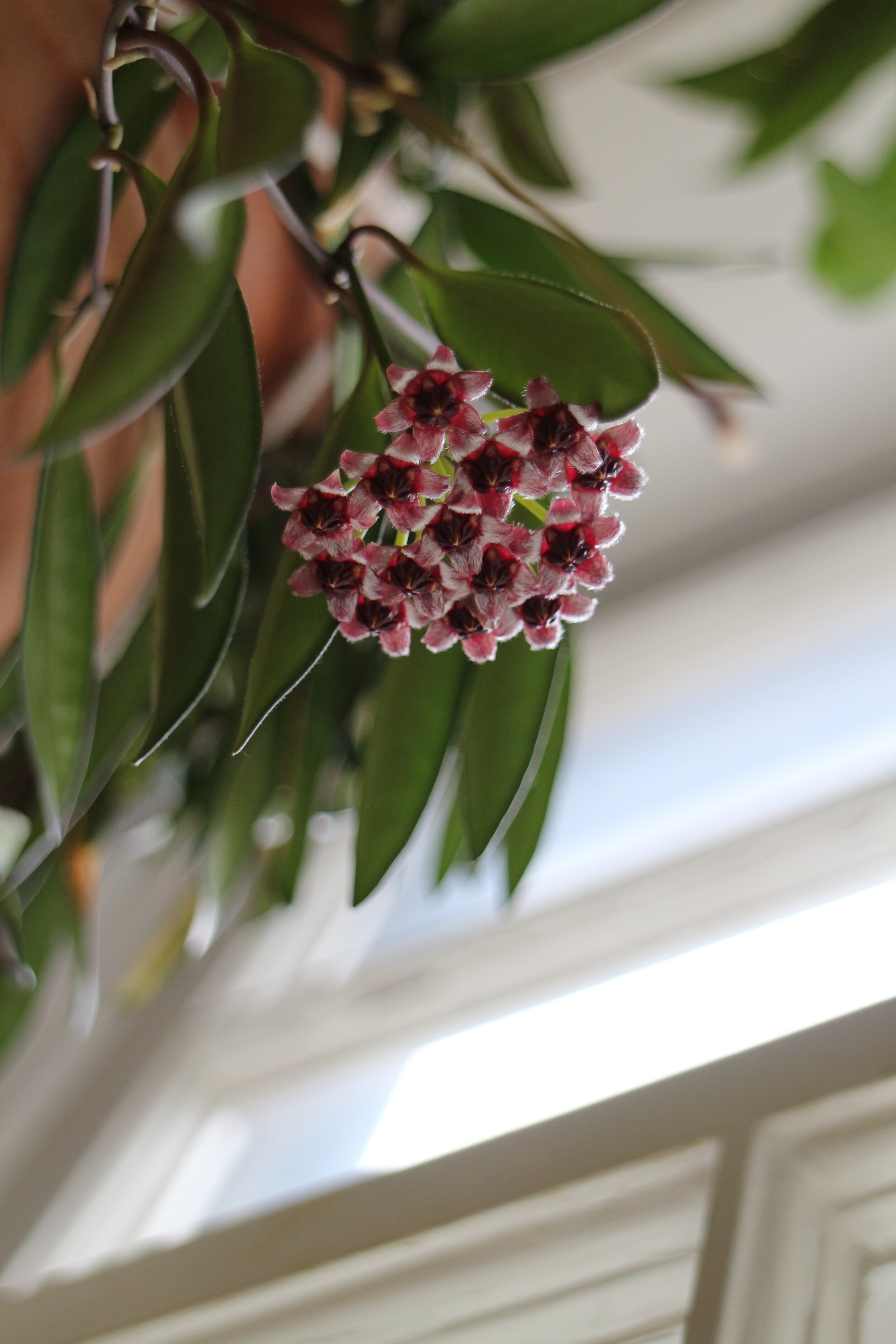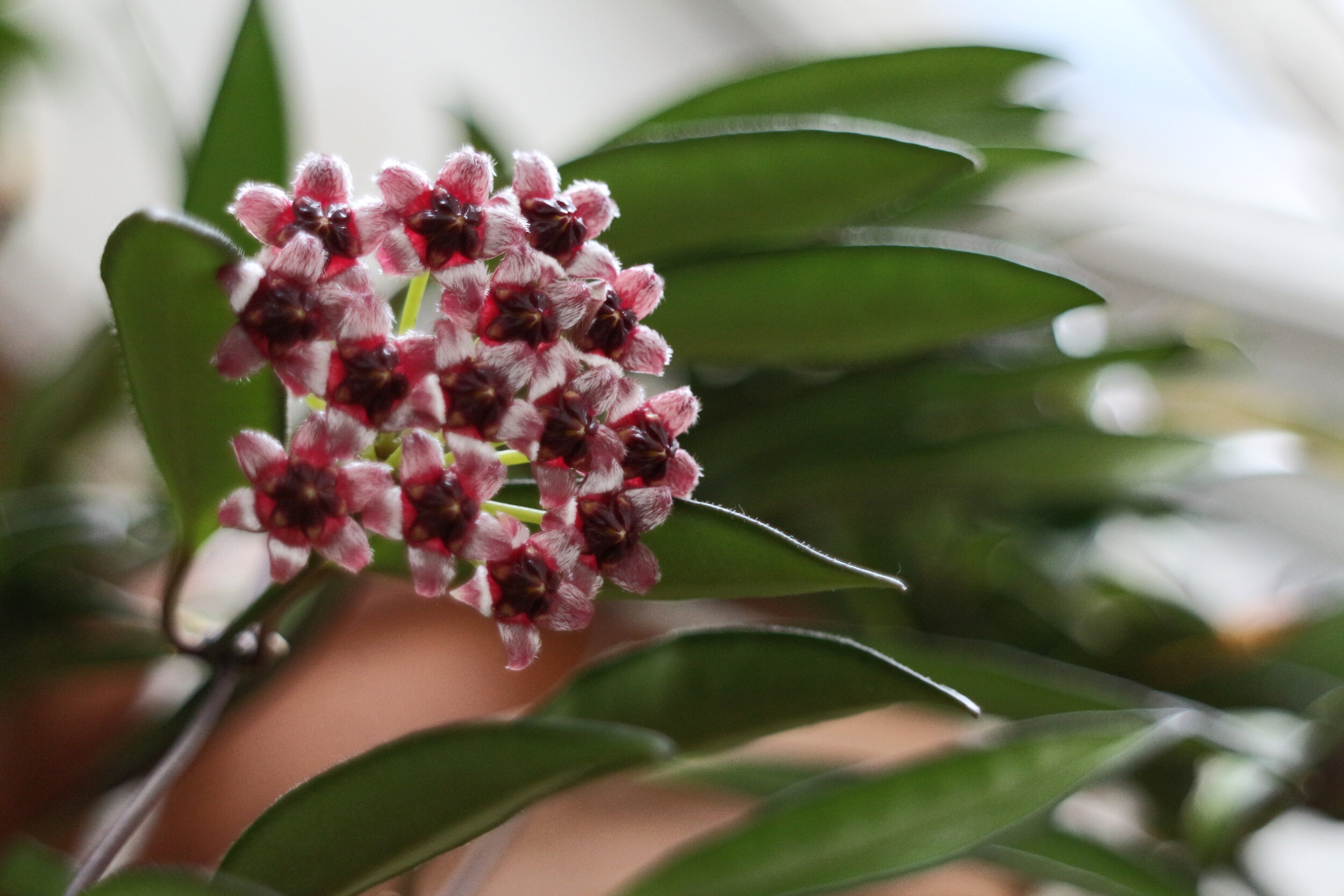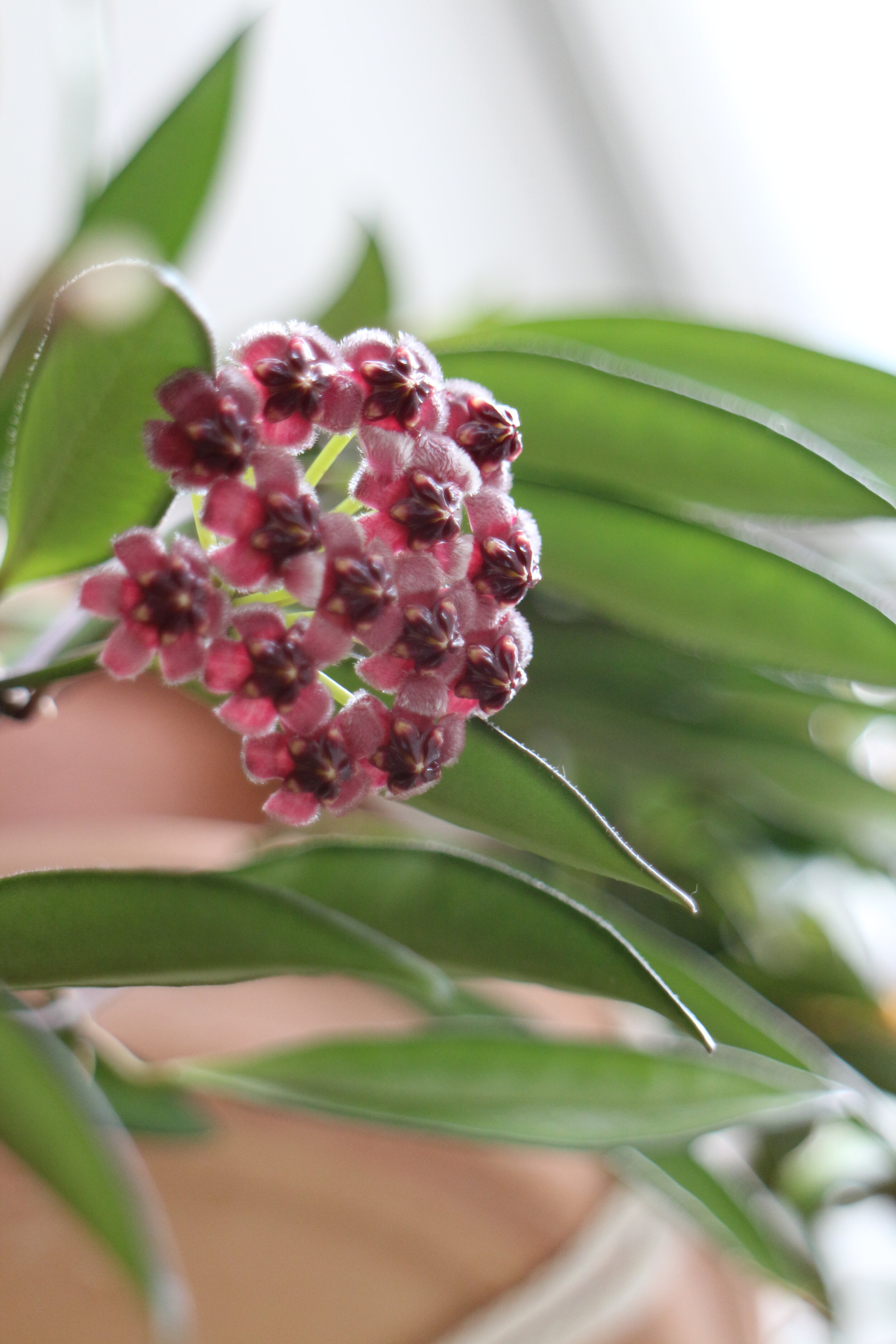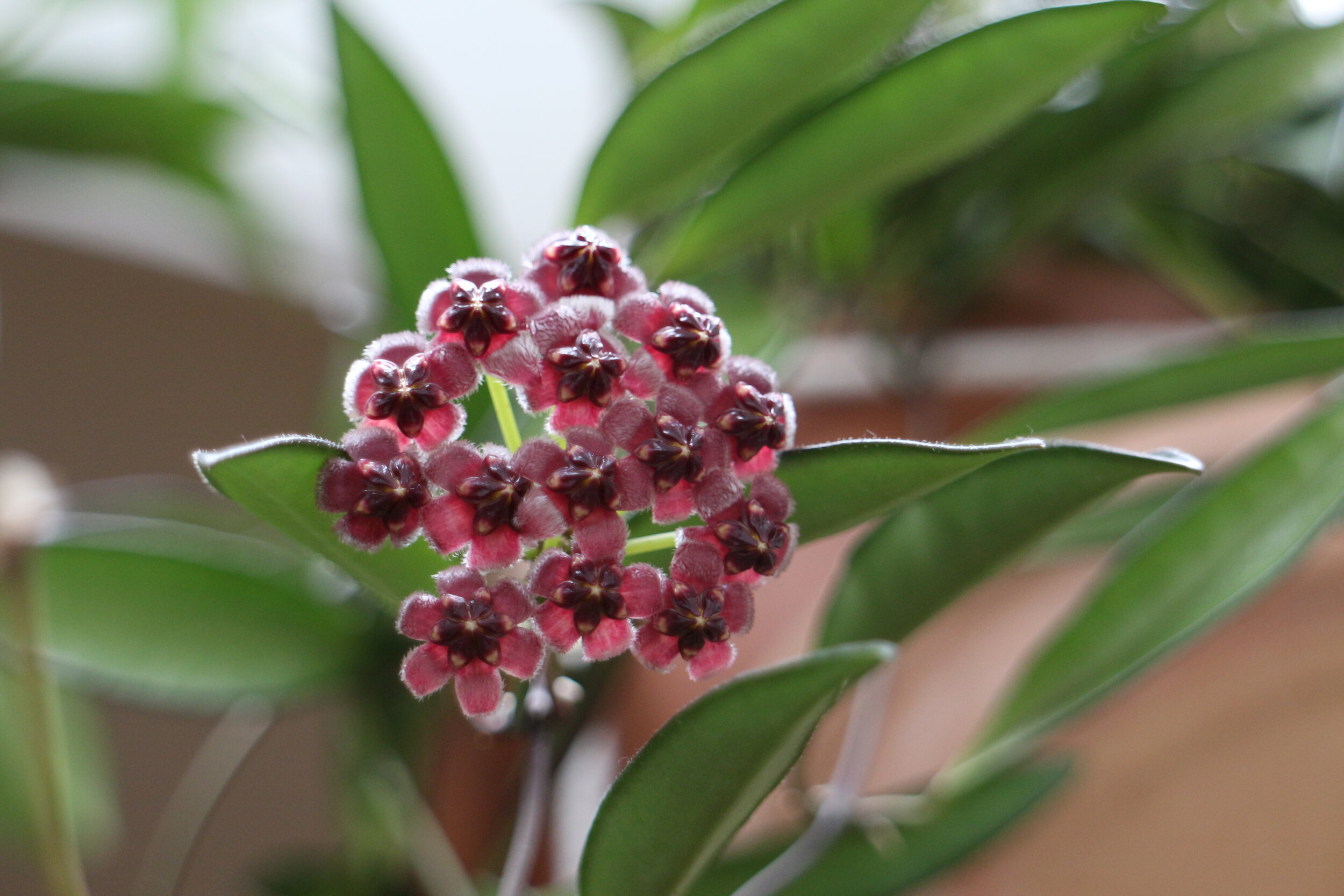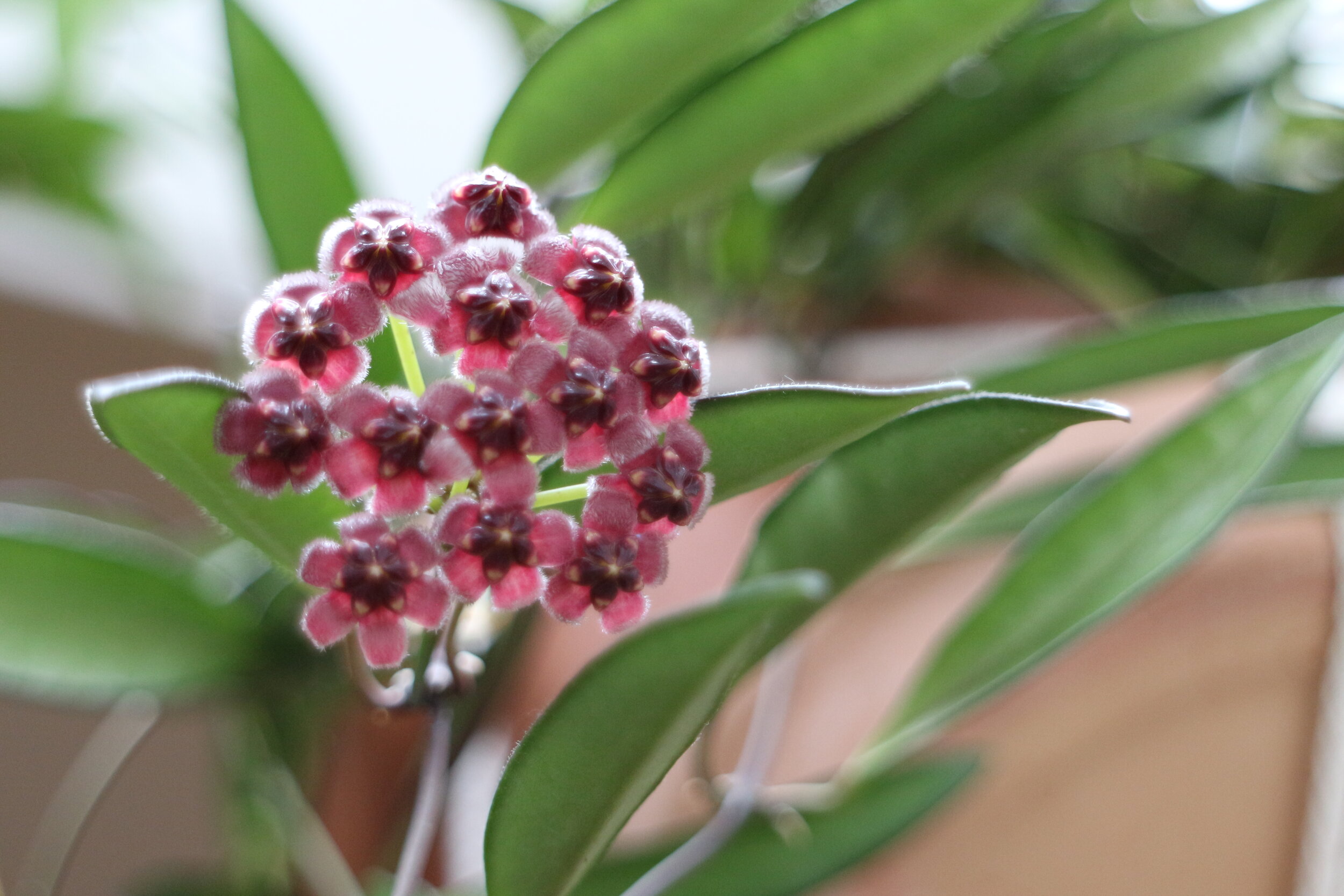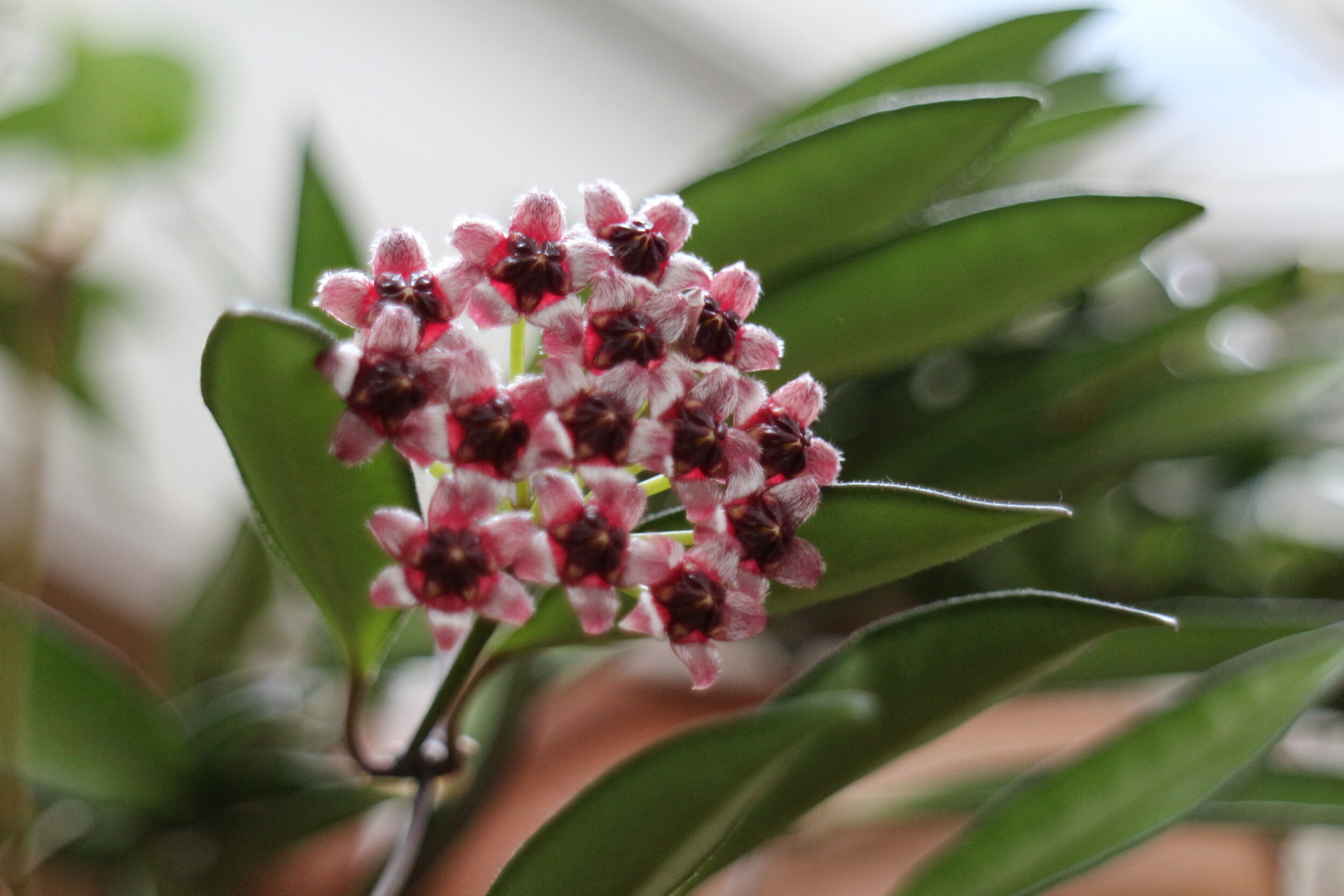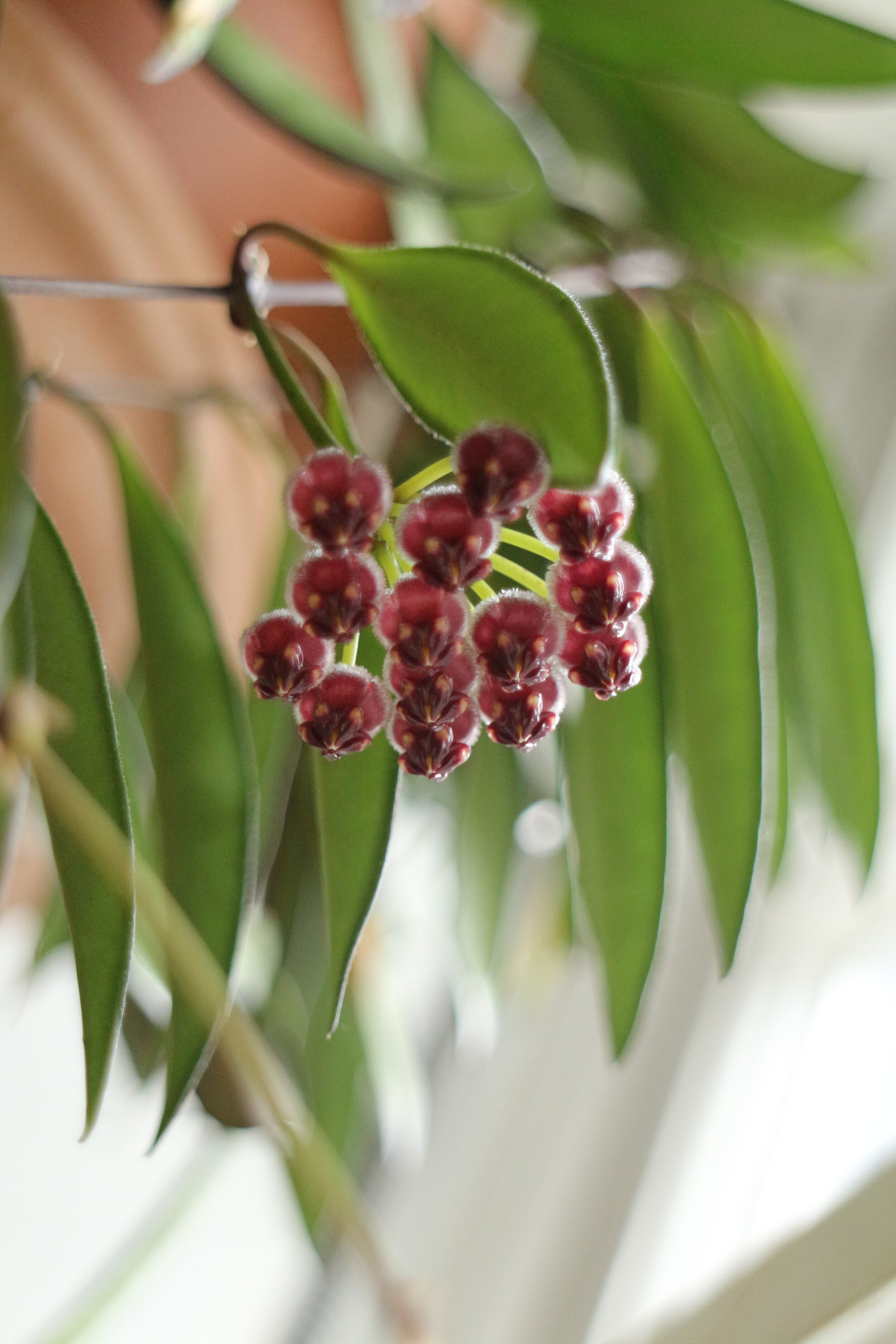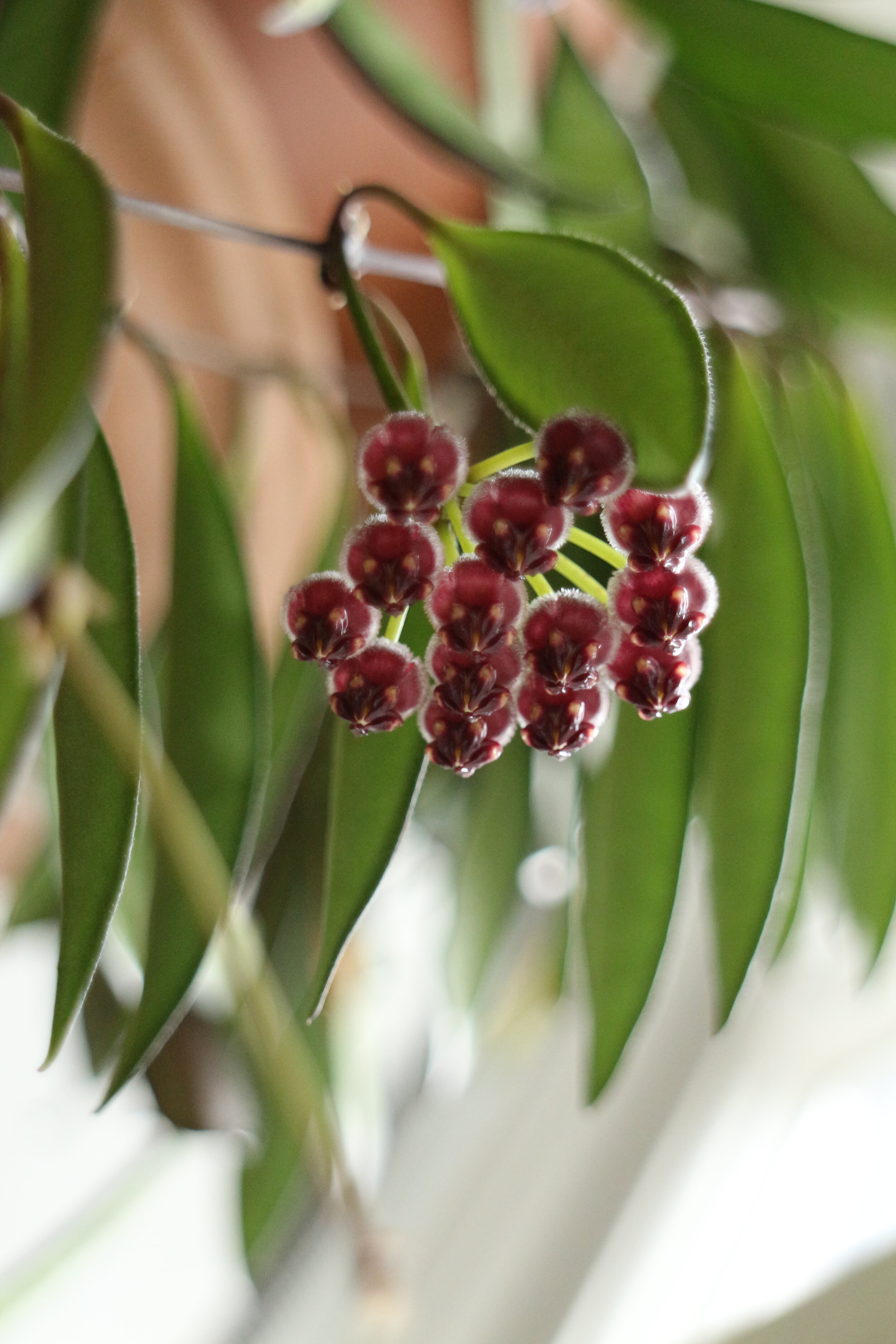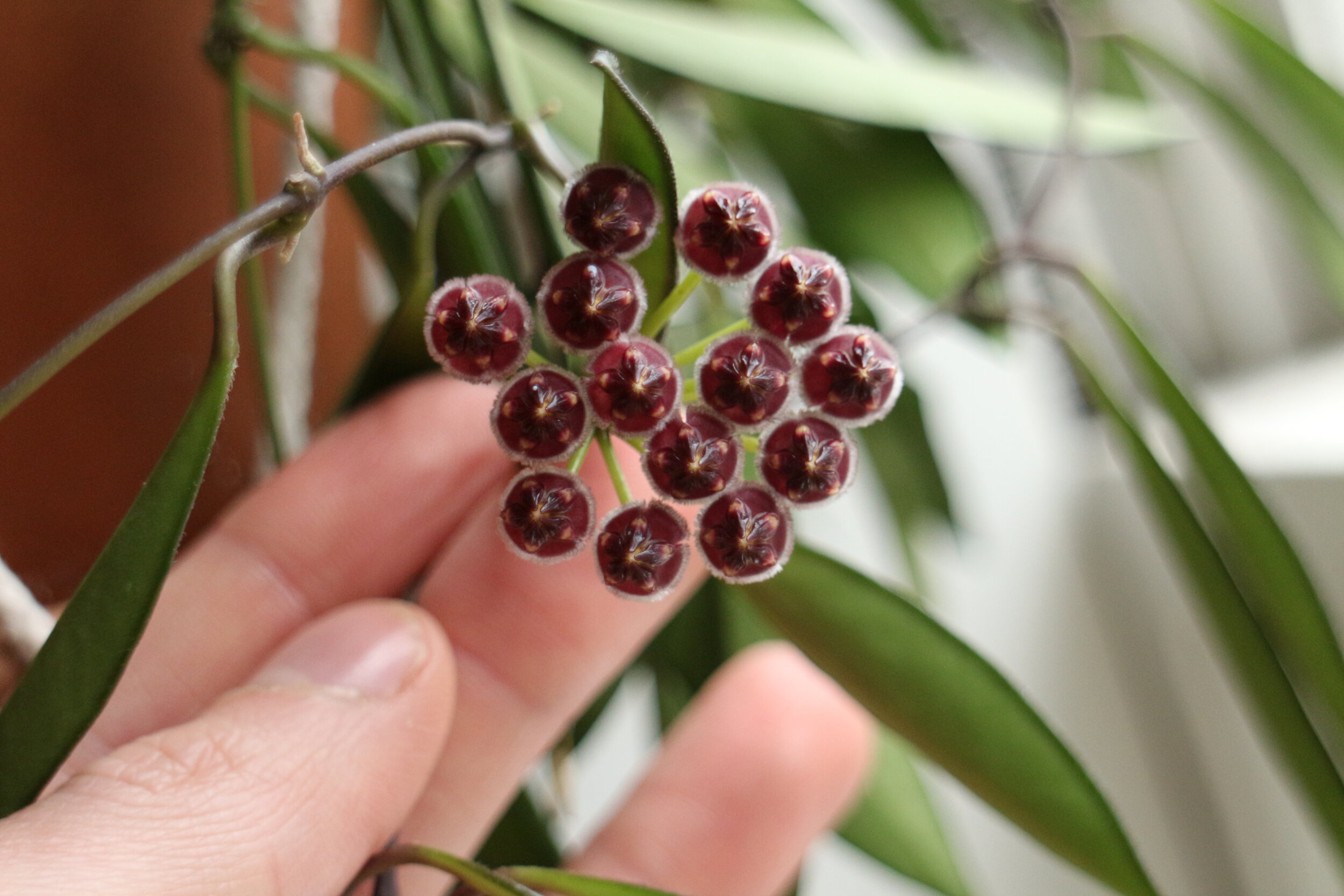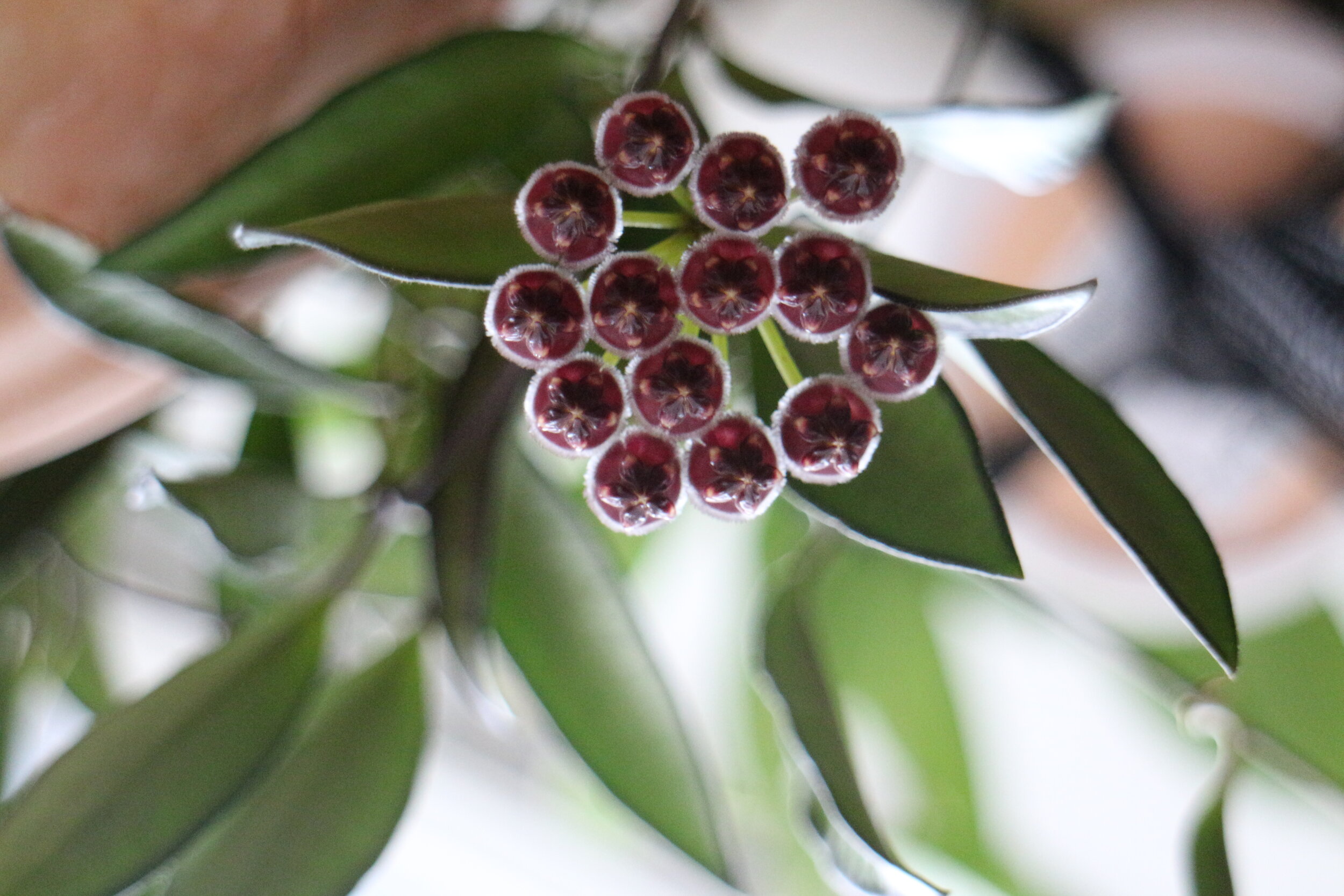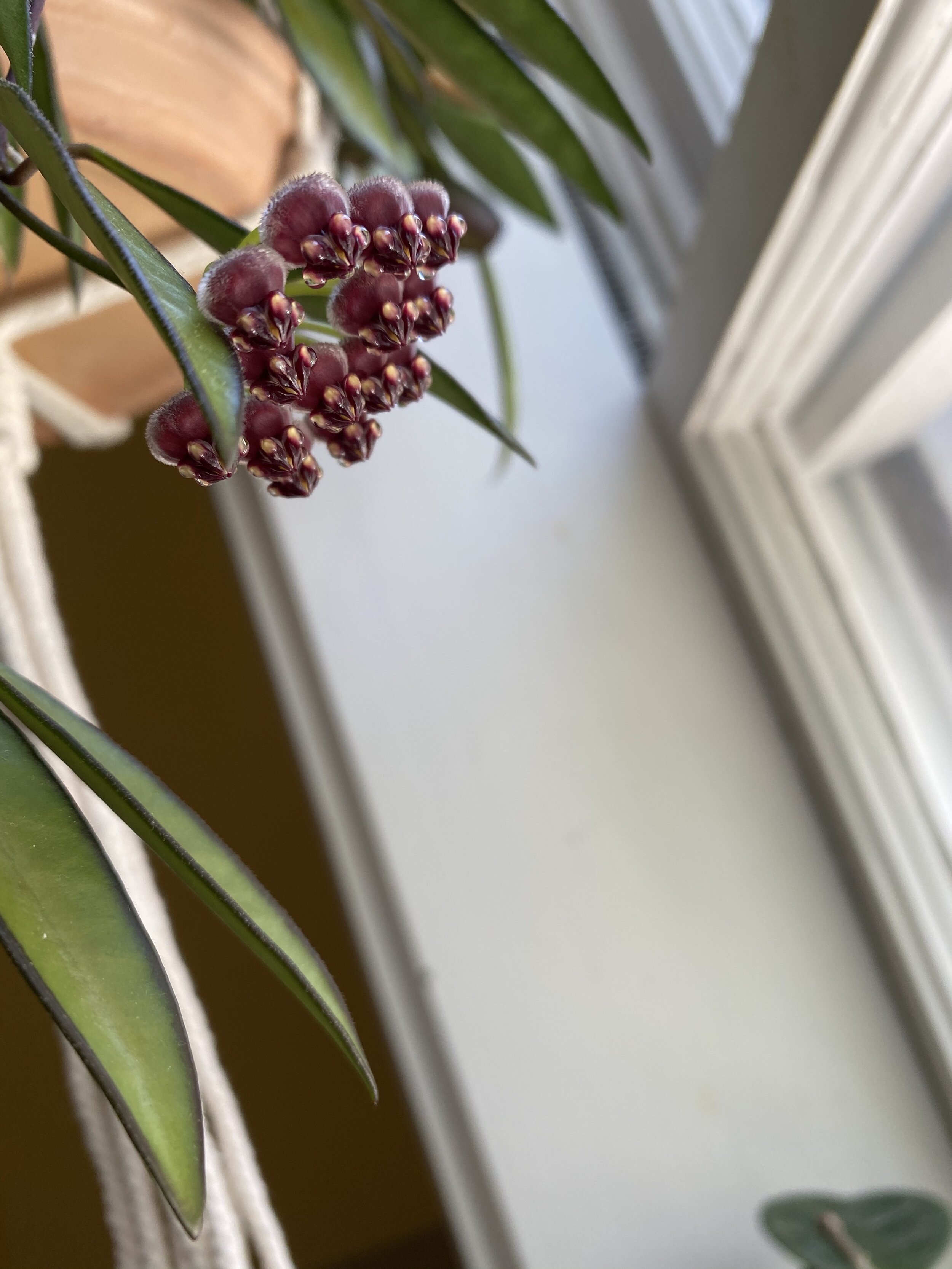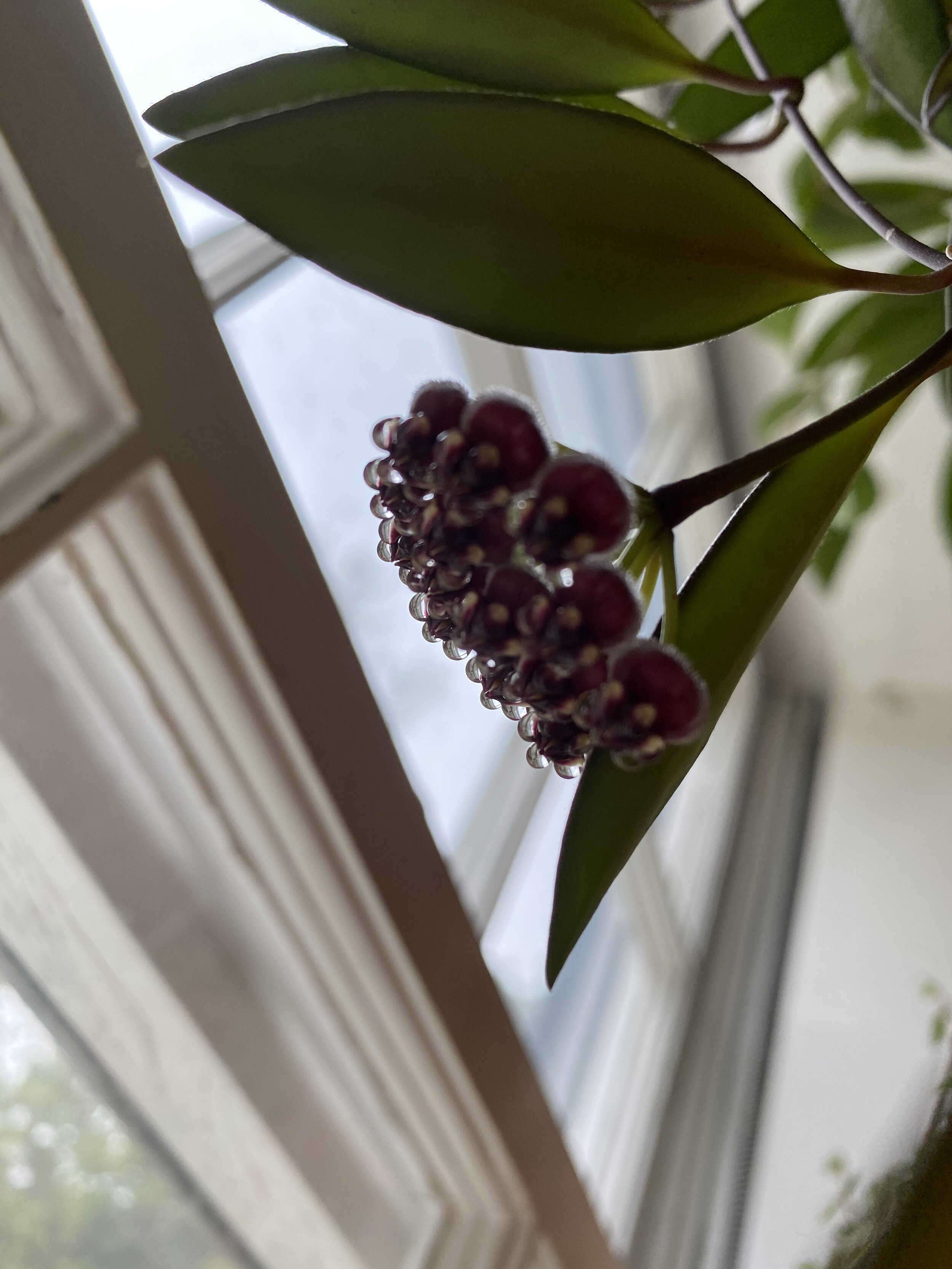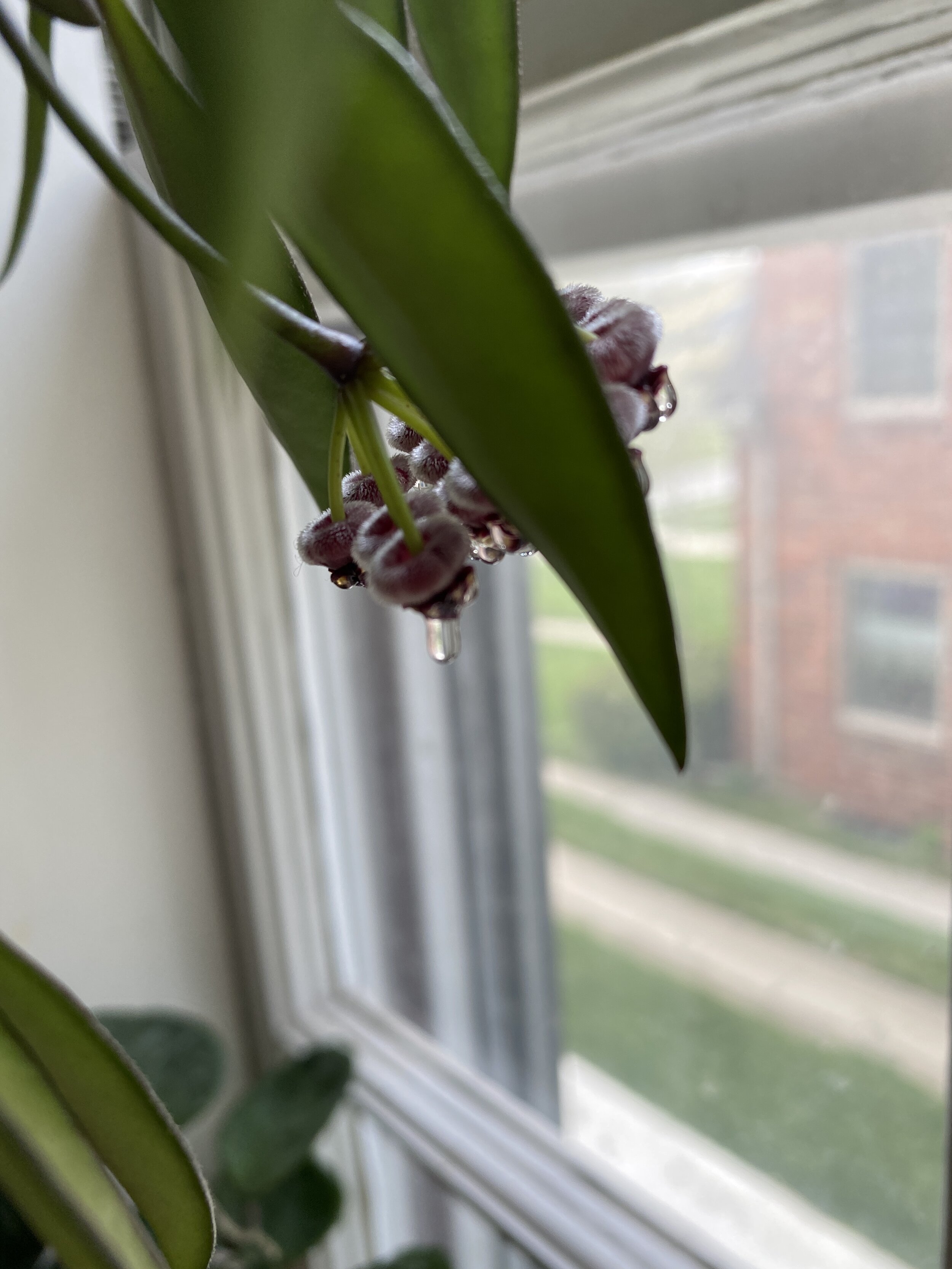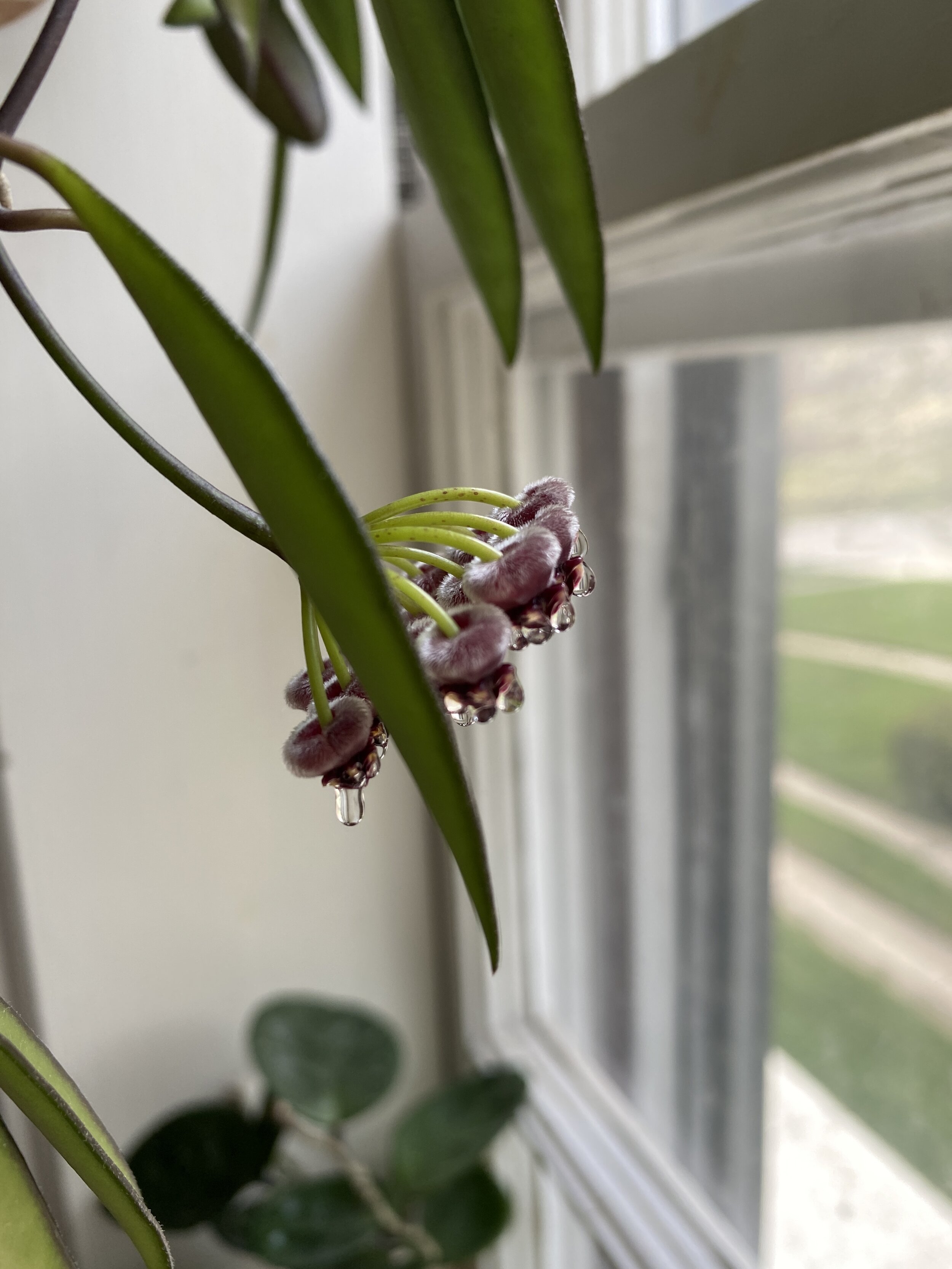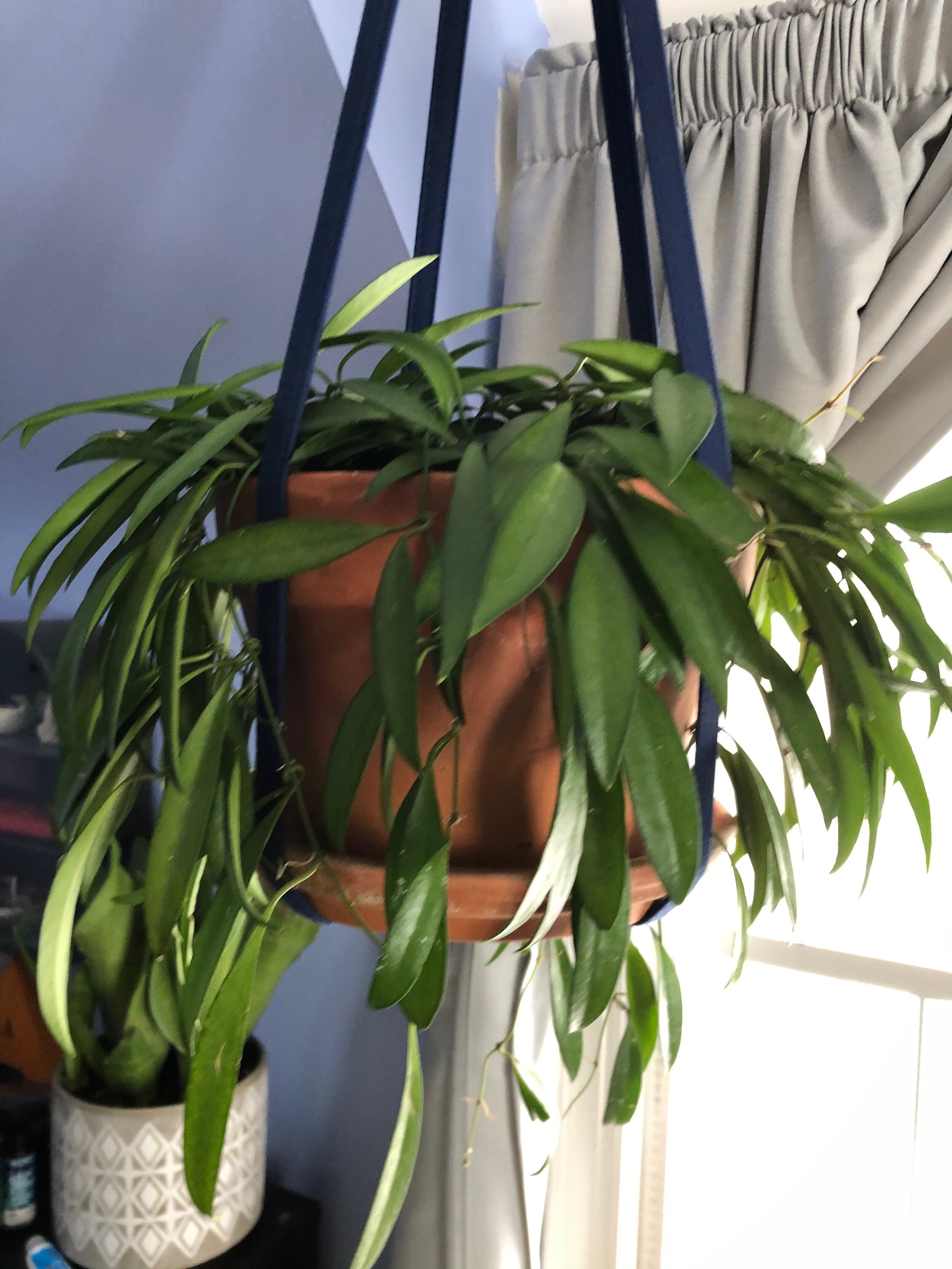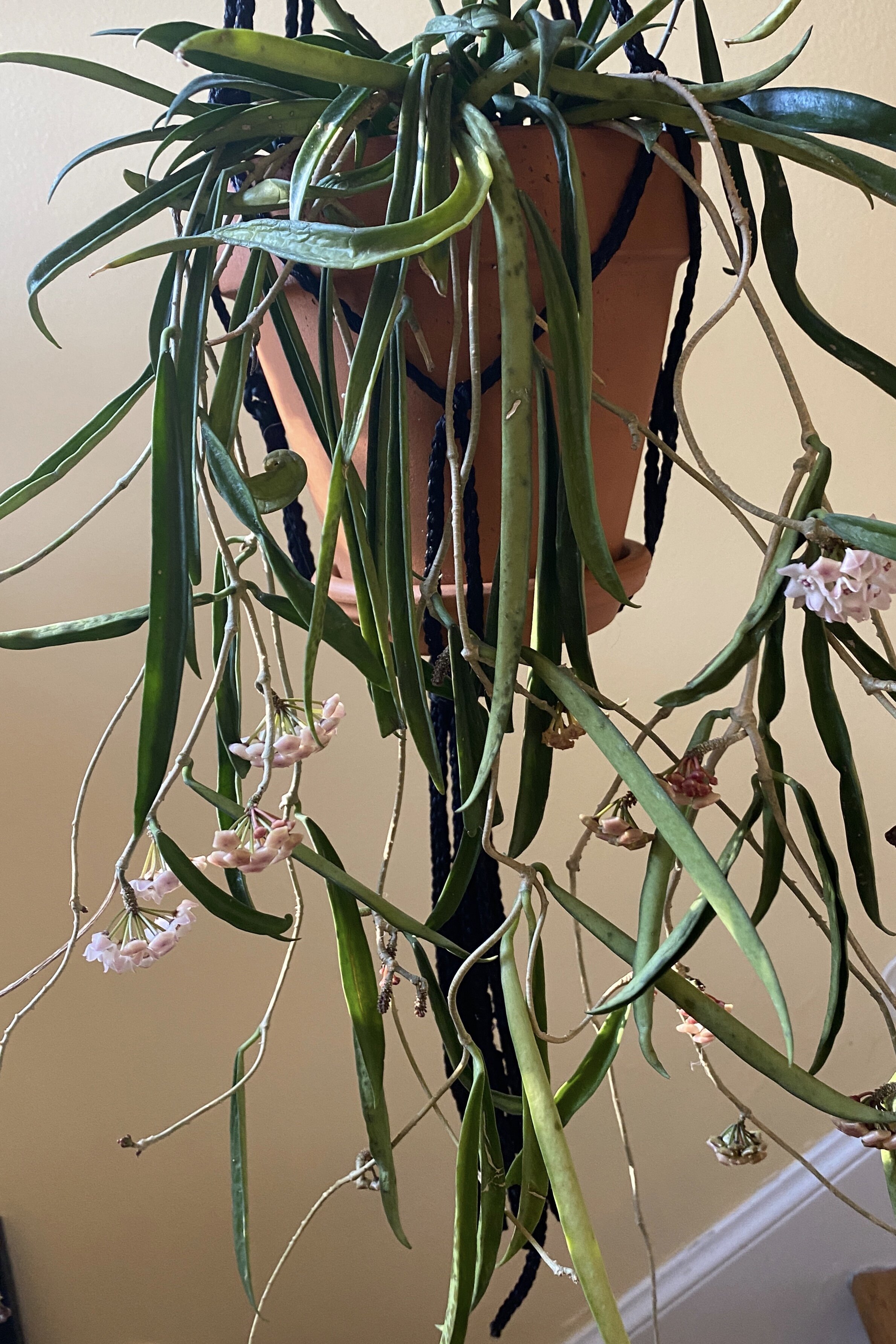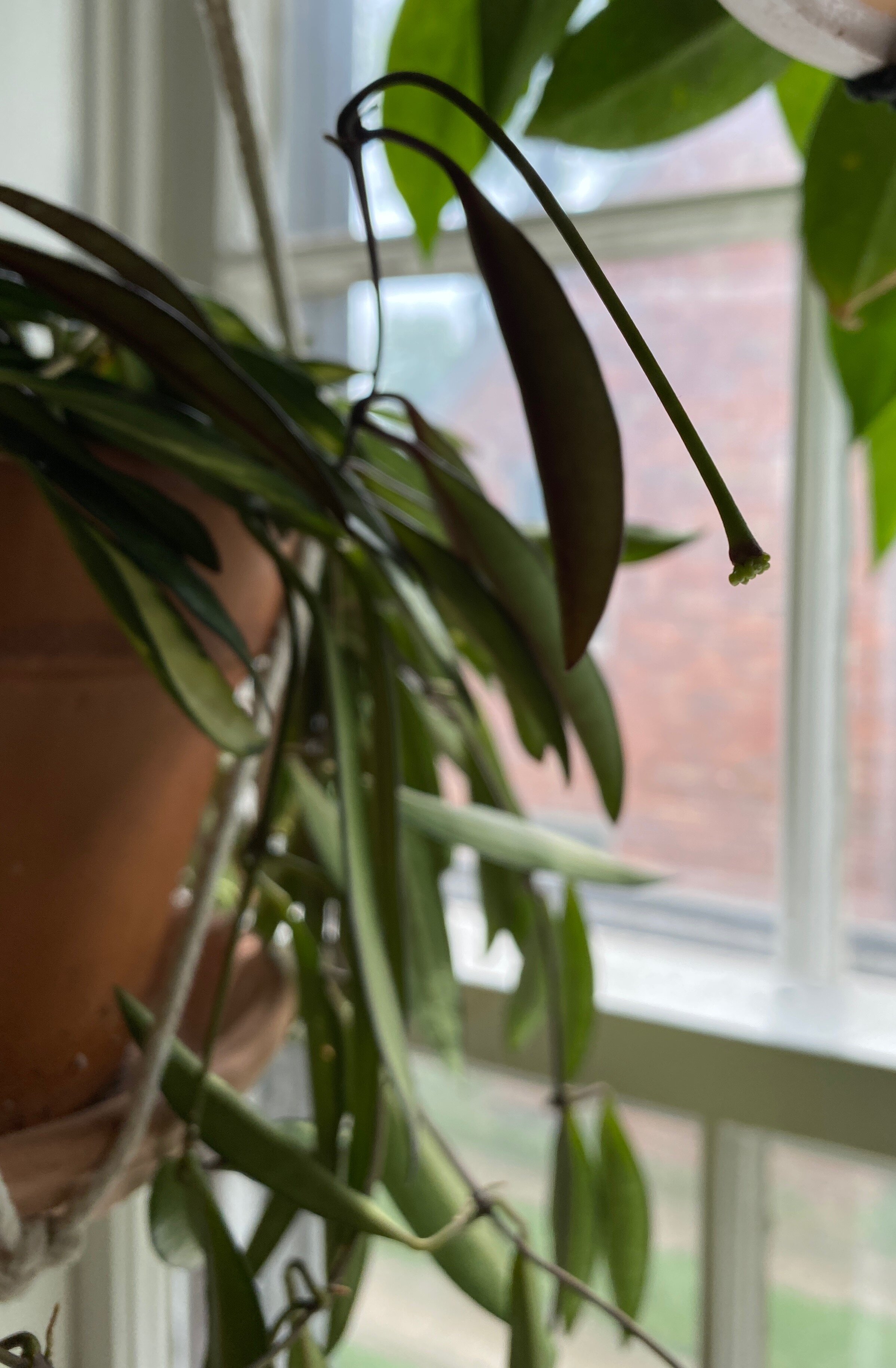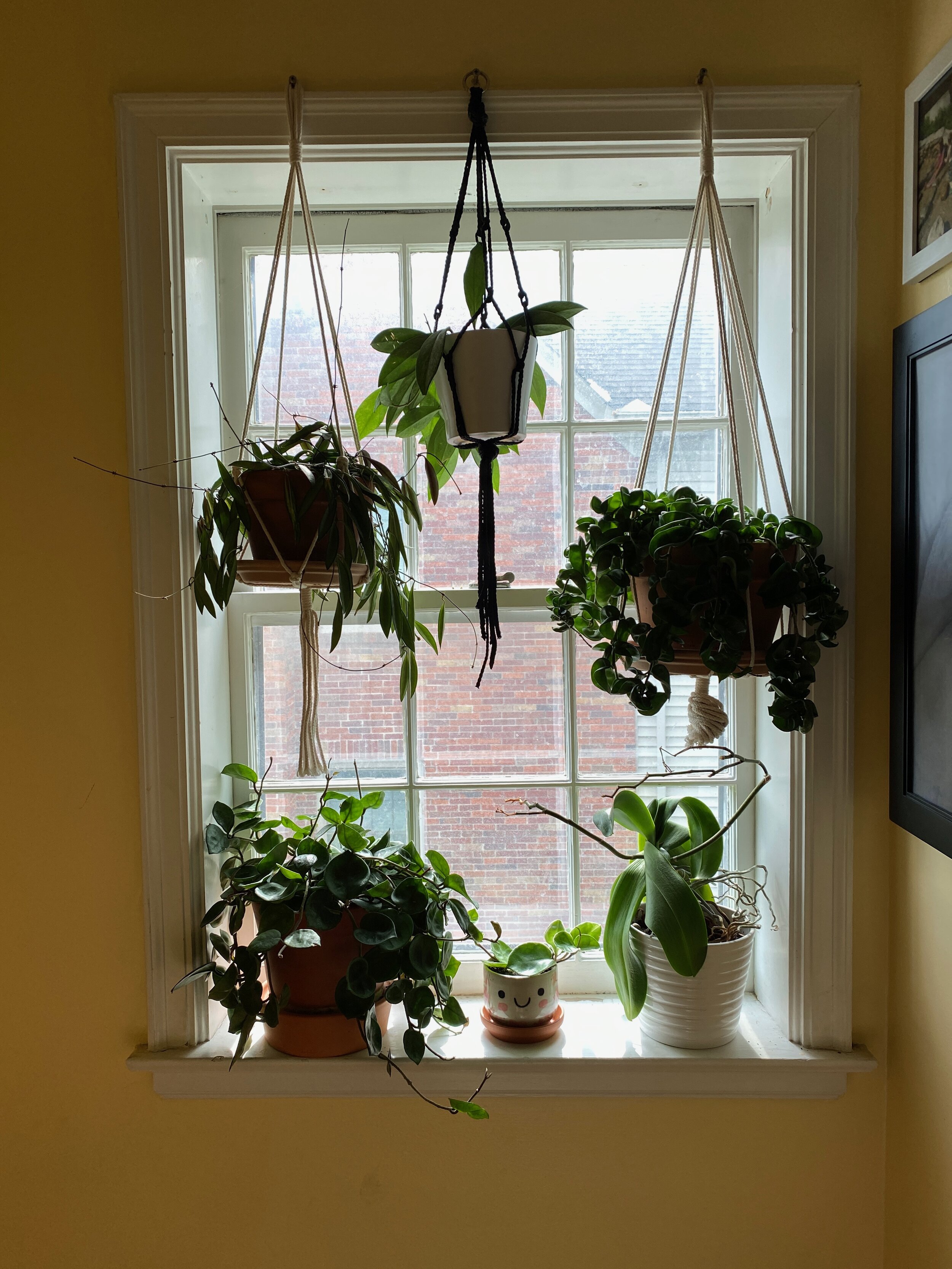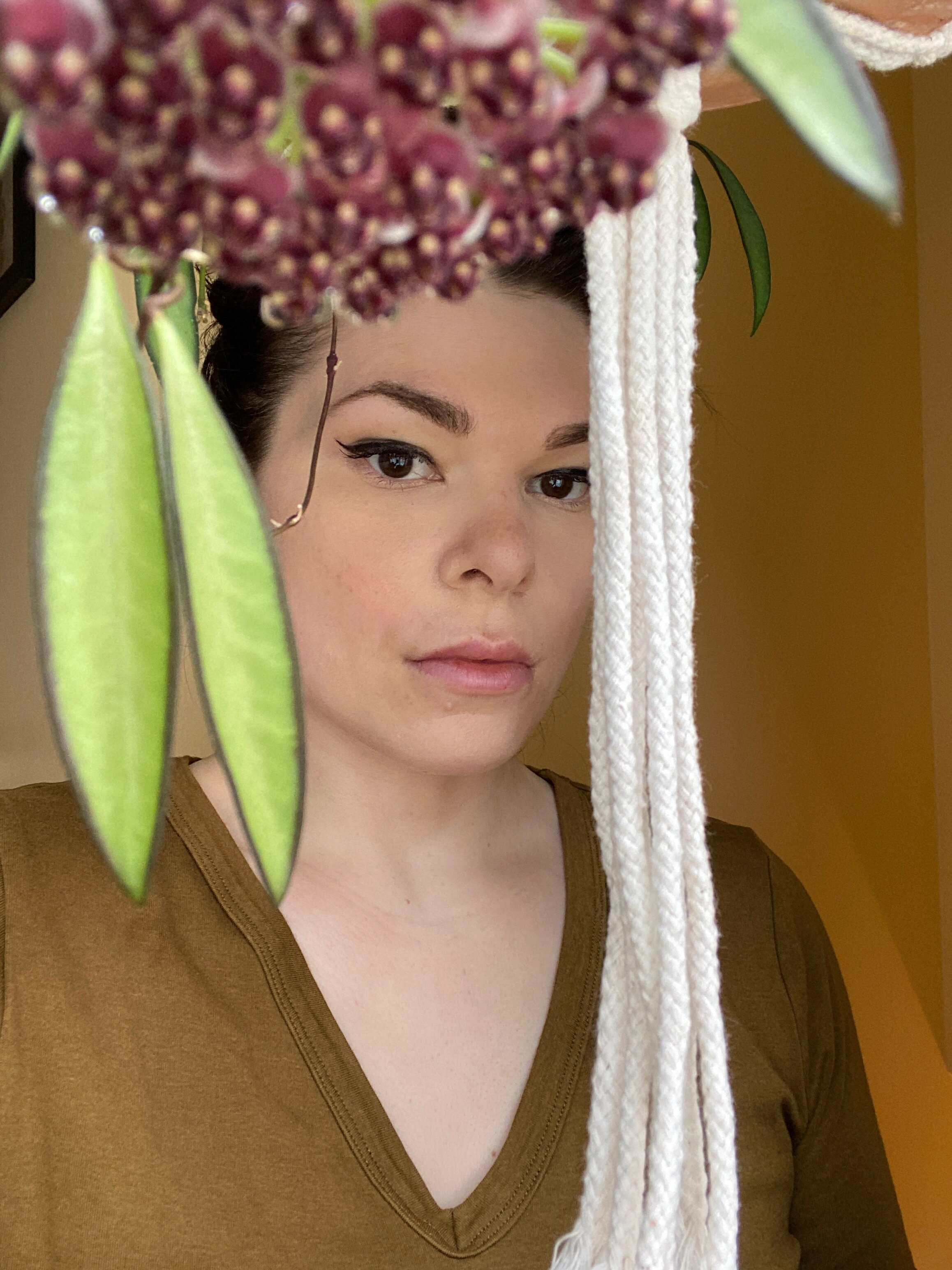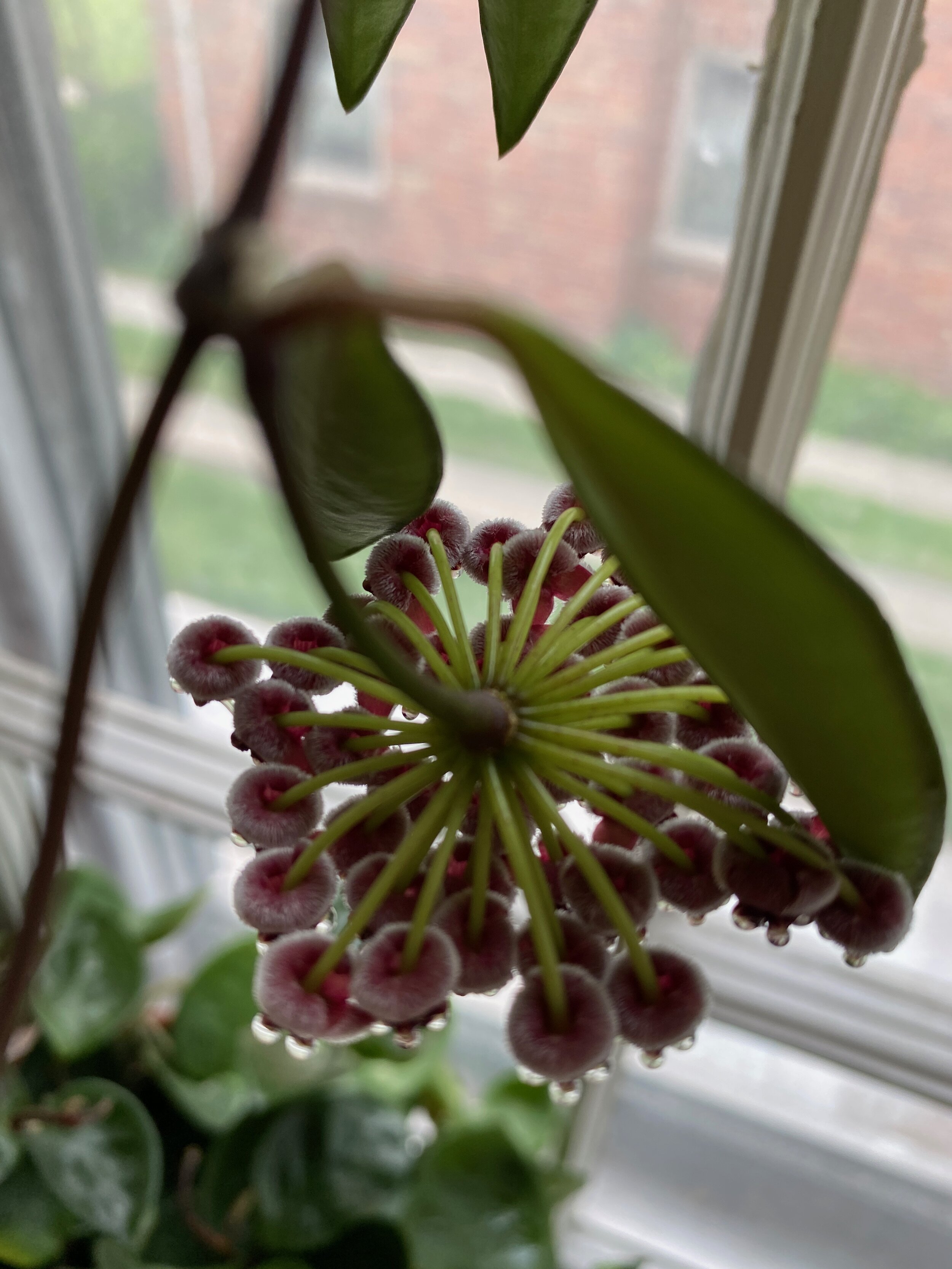Plant Profile: Hoya Wayetii Variegata…Right?
My variegated Hoya wayetii has developed a peduncle and started blooming! Blooms always inspire me to write a plant profile. They make me feel like I can see success with the plant, and I want to share that. I’m going to start with the back story on this particular plant, and then get into a few of the differences between kentiana, wayetii, and longifolia. After that, I’ll talk growing conditions, potting mix, watering, bloom tips, and any other information that I’ve found to be crucial for growing this plant. If you’re just here for the bullet points on how I’ve been successful with this plant, you can skip ahead here.
Backstory
I purchased this plant on June 7, 2019. I love how, as I write this blog, it’s just beyond the two year anniversary of owning this plant. I purchased two plants, actually, each in four inch nursery pots from the “dead rack” at a nursery in Indiana. They cost $4.50 each, marked down from $9 each. I didn’t have high hopes for this pair at all. They didn’t look bad necessarily, but the leaves looked a little dehydrated. Additionally, they had been relegated to a dark corner underneath a table, so I knew there would be some recovery involved in the process of growing them. Still, at $4.50 each, I felt like it was worth the risk. I hadn’t seen variegated wayetii available at any other nursery, plus, I like a bargain. Here’s one of the two plants photographed in the nursery where I purchased it. It had no label aside from the price tag.
Looking a little rough, but still worth a shot at redemption, don’t you think? I promptly potted the two plants together, hoping for a more full specimen. I placed the plant in an east facing window where it proceeded to do absolutely nothing for the next year. I attribute this to two factors. First, I used a pot that was too large. The width was fine. It was all I had on hand at that time to accommodate the plants, so I told myself it would do. The depth, however, was too much. I typically grow my Hoya in terra-cotta that’s as close to the size of the root ball as possible. In this case, that didn’t happen for the first year. The second factor was the light. I later found that east light isn’t enough in my specific growing conditions for this plant. We’ll get to what worked soon. Here are some photos that span about a year’s worth of time. They show the relative lack of growth and progress that the plant made in that time.
Occasionally, a new maroon leaf would spring forth, but it wasn’t often within the span of that first year. Very few, if any, vines grew during this time. It was (overall) a very unproductive time, and I was getting plastic plant vibes from this little wayetii the whole time. I didn’t have much hope, but it’s rare that I completely give up on a Hoya. Finally, just shy of a year after purchasing the plant, I repotted it and moved it to a west window where my Orchids and a few other Hoya were thriving. I felt like this plant had been hanging on for a year, and it deserved a chance to grow.
I repotted the plant into a short 6” terra-cotta pot, gave it a hanger, and let it soak up some sun in the west window where my H. longifolia and H. carnosa were already living happily. It didn’t take long before I noticed new vines growing in all directions. The vines were spilling over the sides of the pot like never before. They were growing straight up like little rockets, following the macrame up until their weight brought them down. I had to dip around them as I walked by because they reached straight out into the hallway. It’s so fulfilling to see a formerly plastic plant begin to take off with new growth.
In March of 2021, I was practicing some basic plant care when I noticed that the plant had formed a peduncle and was working on its first bloom! Notice the bloom in the bottom right corner of the photo below.
The two above photos capture the moment when I first spotted the blooms, so I can’t say exactly how long it took for the peduncle to grow and get to this stage of development. This was late March. In early April, things had really taken off.
On April 12, I was lucky enough to catch the flowers just as they were opening. It was a crazy intersection of coincidence and great timing, because I normally would not have been around to see this stage of the flowering. I love the colors and textures that are present here as the flower begins to open. It almost looks like hair, or downy baby duck fluff.
And within a matter of hours, the blooms had fully opened.
About 24 hours later, the flowers began to seep with nectar. It wasn’t messy. The flower cluster wasn’t excessively dripping to the point of needing cleanup, and overall it wasn’t any trouble. Even if it was trouble, I wouldn’t have minded.
The flowers had no detectable fragrance. If it was there, it was subtle enough to sneak past my nose blindness. Usually, I only notice a moderate or strong fragrance when a plant has more than one bloom open at a time and I’m right up on it. One bloom on this plant isn’t really enough to stop me in my tracks, unfortunately.
The Kentiana, Wayetii, Longifolia Dilemma
Misidentifying a Hoya plant is far from hot news in the plant community. It happens all the time. Not only do plants present in completely different ways when exposed to two different sets of growing conditions, they can even present differently when the growing conditions are alike. I often hear that there are only two ways to identify a Hoya, though I’m not a huge subscriber to this belief. First, there’s identification by actual plant DNA, genetic testing for a plant. This certainly isn’t going to be happening as common practice. Far from it, in fact. Most Hoya enthusiasts aren’t going to be hitting up their neighborhood plant laboratory to get DNA testing done on their plant. The other, less exact method of identification is by checking the flower when the plant blooms. This, as I said before, can be frustratingly variable depending on your growing conditions. And that’s to say your plant has even reached maturity and readiness for the blooming stage of its life cycle. Sometimes we have a Hoya plant for actual years before it flowers, and that’s a frustrating amount of time to wait just to get a reliable ID. And why are we in this situation? Sometimes (read: frequently, to an absurdly annoying degree) the growers mislabel a plant, and you end up owning something different than you’d originally planned. I could rant about this forever, but I won’t. Bottom line, I believe in at least trying to ID your plant by looking for subtle and obvious habits and anatomy.
As I browse various online forums, platforms, and communities, I notice that this plant comes up a lot as far as identification and misidentification are concerned. Let’s cut straight to the chase and compare these plants. I’ll be using two photos Hoya wayetii and Hoya longifolia. First (or on the left, if you’re reading from a desktop and not a mobile device), a photo of Hoya wayetii, and second (or right, desktop users) is Hoya longifolia. I don’t own a Hoya kentiana, and I try not to grab photos from the internet because I don’t know whose work I’m using. So, we’re just going to use words as it pertains to kentiana.
These three plants have a lot in common because they come from the same “section” of Hoya plants, which means that they are quite closely related. The sections were published in the 1990s by Kloppenburg, a prominent Hoya researcher. You can download his actual work on sections here, but let me tell you from experience, it’s a tedious read. And I don’t mean that in a negative way. The man did his research and then some, and I respect him endlessly.
I think if the foliage of wayetii, kentiana, and longifolia as small, medium, and large, respectively. All three plants have lanceolate leaf shape, which reminds me of a canoe…sort of. They are all divided deeply down the middle length-wise. I can’t speak for kentiana, but both my wayetii and my longifolia bloom in what’s summer in my part of the world.
Hoya wayetii has the shortest leaf, and the most substantial width of the three, though it is still longer than it is wide. The width is about a third of the length. The width:length ratio increases substantially from kentiana to longifolia, respectively. The leaves of Hoya wayetii are thick when the plant is hydrated. if exposed to high or direct light, a deep brown or maroon margin forms along the outside of the leaves. The peduncles are typically green, though they can sun stress just like the leaves. This plant can be green or variegated. I have both, and the one exposed to more light flowers more readily. This plant is frequently mislabelled as Hoya kentiana.
Hoya kentiana has longer leaves than wayetii. The peduncles are darker in color than those of wayetii, they’re more likely to be maroon despite the presence or lack of sun stress. As I browse online, I don’t often see Hoya kentiana, I see Hoya wayetii or its variegated form mislabeled as kentiana. This can be confusing if you don’t have both plants side-by-side to show scale. To say that the leaves are “medium” between the smaller (by comparison) Hoya wayetii, and the longer longifolia isn’t terribly illuminating. I know. They’re “medium” as far as succulence goes in comparison to the other plants, too. And as if this wasn’t confusing enough, the flowers of wayetii and kentiana are also very similar. In my opinion, let me say that once more…in my opinion, the flowers on Hoya wayetii are slightly darker all around compared to those of kentiana.
Hoya longifolia is going to have the longest and most pointed leaf of all three plants. It’s deep green and has the deepest center fold. Hoya longifolia is often called “the green bean,” or “the string bean” hoya because the long, thin leaves coupled with the vines look very much like green beans. You are not likely to mistake your wayetii or kentiana for a green bean plant, I’m fairly confident about that. After growing three longifolias, I really do see why it has these nicknames. There’s a definite green bean vibe going on here. The flowers will not be mistaken for wayetii or kentiana flowers, either. They’re soft pink, and even my nose blind self couldn’t escape the scent. It was very floral to me, but I’ve had friends compare it to candy. Noteworthy: Hoya shepherdii is a synonym for Hoya longifolia, so scratch that name off your wishlist if you already own a longifolia. Unless, like me, you love to own multiples of each plant.
Crucial Care Tips:
Hoya wayetii is a plant that can definitely be grown in basic household conditions. I have several greenhouse cabinets, and I see absolutely no reason why this plant would ever need that special growing environment. Both of my plants have grown and thrived in my house, but as discussed in the opening of this blog, it took some trial and error to find the perfect “goldilocks” moment. Let’s get into it.
Light is the key. If you want blooms, you need to find the right lighting conditions. Match the light to the plant’s needs. This might involve moving the plant around your house like I did, or it might involve a grow light if your house doesn’t have much natural light. If you’re lost on grow lights, I’ve got you. Check out my ebook in my store. In my environment, this plant takes light from an unobstructed west facing window. There are no trees, buildings, or any other whatever blocking the afternoon sun from reaching the plant. My plant does, as seen in some photos above, have the dark rim around the leaves which indicates that it’s receiving a good amount of sun. In another geographic location, the light level might not be just right. Follow your gut and the cues that the plant gives you.
This is not an especially thirsty plant in my environment. I watered it infrequently when it was in lower light, and now that it’s in more light, I take visual cues from the plant. I water when it looks droopy, when the leaves wrinkle, get soft, or generally appear lackluster. I don’t follow a routine for watering, but generally speaking, I water about every 10 days. I check the plant every 3-4 days.
Humidity has never been of great concern in my care regimen for this plant, nor is it for my green wayetii that lives in an east window. Both plants plod along in areas of my house that are not supplemented with humidity regardless of the season. This, at least in my opinion, validates what an excellent plant this is for growing in regular, unmodified household conditions.
I grow this plant in the same epiphytic potting mix that I use for all of my Hoya. If you would like the general recipe, you can find it here (scroll to epiphytic potting mix if you don’t want the full story on soil), and for a deep dive into all things potting mix, you can find an ebook available in my store. Do keep in mind that in the summer or when blooming, the plant needs to be checked for dehydration more frequently. The potting mix is a vehicle that helps transport and maintain water levels for the plant, and knowing your watering habits as well as the needs of the plant will help you find that perfect fit. With all that said, in the summer, I water this plant around every 10 days. I check it weekly.
As always, I prefer close fitting terracotta for Hoya that I’m trying to bloom. I like the breathability for the roots, and I look for a pot about 1-2 inches wider than the root ball l to ensure that growth is being directed to the vines and foliage. I favor the short “Azalea” pots because they’re a couple of inches shorter than a classic terracotta pot. Hoya are epiphytes, they’re used to getting in where they fit in, so to speak. Keep in mind, this doesn’t mean that the plant should ever be packed into the pot tightly. Epiphytes are accustomed to air flow around the root area. This means that picking a properly sized pot with proper potting mix is crucial.
My plant has taken both spray fertilizer for Orchids, and water soluble fertilizer from my local nursery. Currently, it’s not on a fertilizer at all. It hasn’t been since last fall. I’m a little behind on getting my supplies in place for the growing season. When I (soon) get back into the swing of things, I’ll begin by waiting for a time when the plant is due for a deep watering, and I’ll flush the plant and pot with fresh water for about 3-5 minutes to clear out any residue, minerals, or salts from last growing season. Then, with the next watering, I’ll fertilize.
The blooms last about a week. There might be a fragrance, but don’t ask me! I’ve noticed that the individual flowers within the cluster (or umbel) increase with each time the plant blooms. In my neck of the woods, this plant blooms in the summer if it’s happy.
In Conclusion.
I don’t know how this plant has perfected the ability to sneak up on me, especially now that I’ve been looking at it every day as I write about it and track the blooms, BUT, it grew another peduncle and is setting up to bloom again.
I’m always thrilled to talk plants. Really. Comment below, send me an email, or find me on Instagram. Tell me all about it!
If you’re looking for more info on Hoya plants, check out my blogs on Hoya linearis, Hoya sp aff burtoniae, Hoya serpens, Hoya krohniana, Hoya longifolia, or find my general hoya page here.
And don’t forget to check out my handmade pottery that’s now available in the store!

